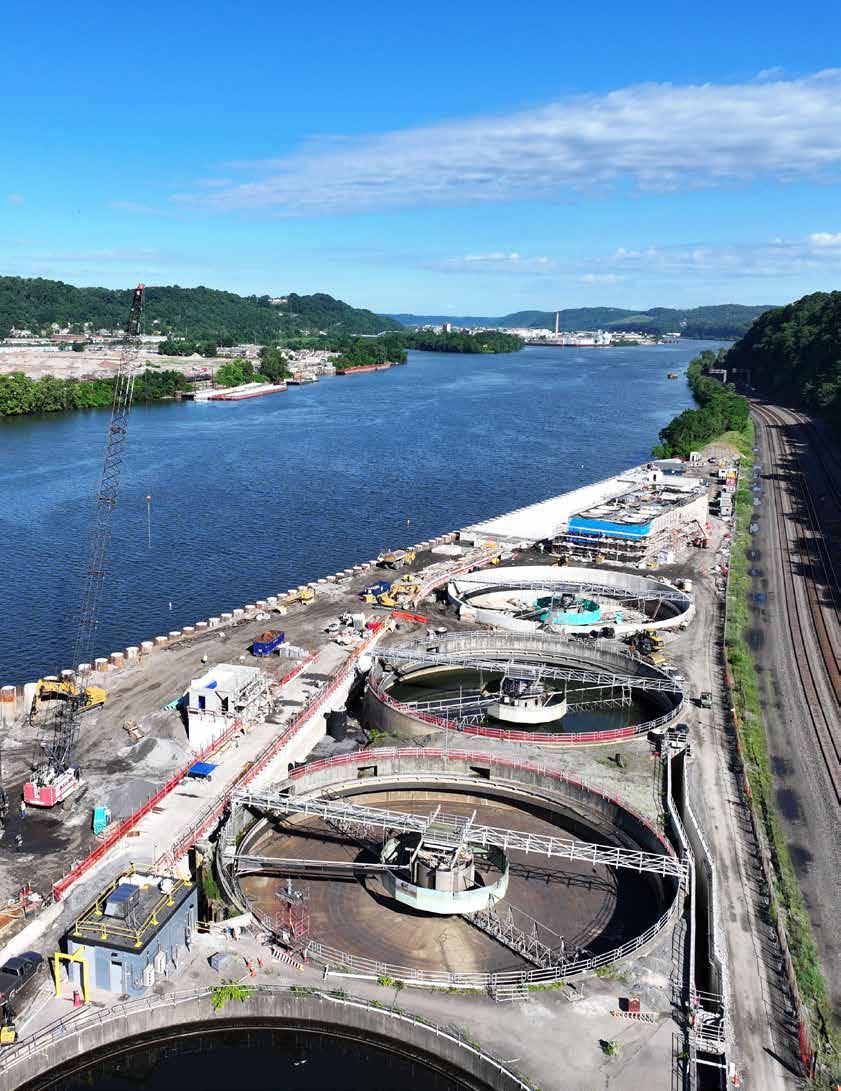

ENVIRONMENTAL CONSTRUCTION UPDATE
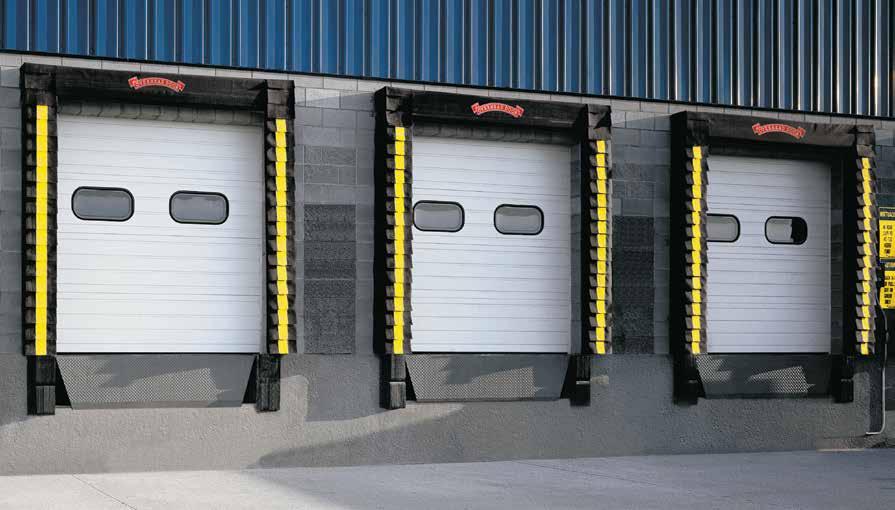


14th Annual Pittsburgh Transportation, Building, & Construction Awards Luncheon

March of Dimes will present its 14th Annual Pittsburgh Transportation, Building, & Construction Awards Luncheon to honor the leaders and projects from both the public and private sectors of the transportation, building, and construction industries.
When
Tuesday, September 10, 2024
2024 Honorees
Local Labor Leader of the Year
Where
The Westin Pittsburgh 1000 Penn Avenue, Pittsburgh, PA 15222
Thomas Melisko, Jr. Business Manager, International Union of Operating Engineers Local 66
Industry Leader of the Year
Stephen Shanley, Director, Allegheny County Department of Public Works
Building Project of the Year
UPMC Mercy Pavilion, Owner: UPMC
Transportation Project of the Year
SR 28 Highland Park Interchange Improvement Project, Owner: PennDOT District 11-0
Infrastructure of the Year
University of Pittsburgh Upper Campus Chiller Plant and Distribution, Owner: University of Pittsburgh
To learn more, please contact Becky Clement at rclement@marchofdimes.org, 412-301-7433, or visit marchofdimes.org/events/pittsburghtbc.
March of Dimes believes in a world where every mom and baby is healthy regardless of wealth, race, gender, sexual orientation, or geography. The US remains among the most dangerous developed nations for childbirth, especially for families of color. Through research, programs, and advocacy, our supporters enable us to be there for parents throughout their pregnancies.



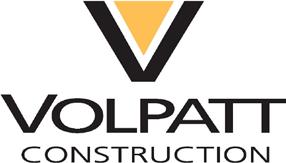
# W e A r e V o l p a t t ustrial institutional





PUBLISHER
Tall Timber Group www.talltimbergroup.com
EDITOR
Jeff Burd 412-366-1857
jburd@talltimbergroup.com
PRODUCTION
Carson Publishing, Inc.
Kevin J. Gordon
ART DIRECTOR
Carson Publishing, Inc.
GRAPHIC DESIGN Blink
CONTRIBUTING PHOTOGRAPHY
Allegheny County Sanitary Authority American Subcontractors Association Green Building Alliance Mascaro Construction LP Master Builders’ Association of Western PA NAIOP Pittsburgh Pittsburgh Water and Sewer Authority
ADVERTISING DIRECTOR Karen Kukish 412-837-6971 kkukish@talltimbergroup.com
MORE INFORMATION:
BreakingGroundTM is published by Tall Timber Group for the Master Builders’ Association of Western Pennsylvania, 412-922-3912 or www.mbawpa.org
Archive copies of BreakingGroundTM can be viewed at www.mbawpa.org
No part of this magazine may be reproduced without written permission by the Publisher. All rights reserved.
This information is carefully gathered and compiled in such a manner as to ensure maximum accuracy. We cannot, and do not, guarantee either the correctness of all information furnished nor the complete absence of errors and omissions. Hence, responsibility for same neither can be, nor is, assumed.
Keep up with regional construction and real estate events at www.buildingpittsburgh.com
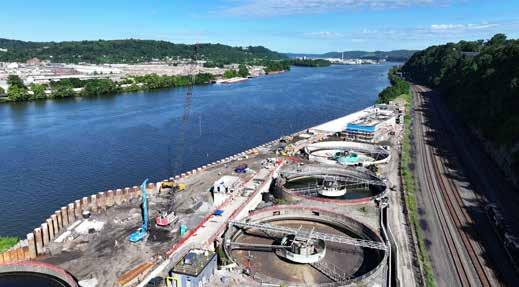
Catalysts of Change: Exploring Mega Trends Re-Shaping the Engineering and Construction Industry (Part 2)
for
On the cover: ALCOSAN’s North End plant expansion. Photo by Mascaro Construction.














PUBLISHER’S NOTE
There are many days when I understand what Will Ferrell’s character in Zoolander meant when he said he felt like he was taking crazy pills. Or maybe I’m just getting too old for this nonsense.
Our governments are again trying to fix problems that they cannot fix. The “solutions” seem unlikely to work and have cost lots of taxpayer dollars. The problems that exist are mostly problems that could not be avoided, like our demographics or the impact of a global pandemic. Some of them, like the problems in the office market or housing affordability, simply will not go away until conditions rebalance. That means that some people will feel pain. As a community, we should want to do whatever we can to mitigate that pain, but history has proven that a government policy will do little to that end and will almost certainly create an unintended consequence of equal or greater pain.
The climate feels very similar to the one that existed in 1994, when I started Pittsburgh Construction News. There was a lot of spaghetti being thrown in the wall. There were a lot of government officials determining what the market might want. There was a lot of money being thrown in many different directions. There were also a lot of hands reaching out to get some of that money. Lots of that money went wasted.
In recent weeks, we have heard about a plan – developed by an out-of-town consultant – that will take property Downtown to create parks and outdoor space that will make Downtown feel more like a neighborhood for residents. Was the lack of public play space the reason more people don’t live Downtown? In February, the City of Pittsburgh narrowly approved spending $6 million – again with out-of-town firms – to develop a comprehensive plan to create a road map for development. Is it your experience that the private sector is not developing more in Pittsburgh because it needed a new comprehensive plan?
I had a conversation in early June with an architectural firm owner and a development leader of one of the region’s major institutions during which they both expressed frustration that it took the same amount of energy and effort to get approval to build a trash enclosure as it does to build a new building. That seems like something that could be fixed. Ask a residential developer what they must go through to build a duplex or set of townhouses on an empty city lot that previously contained a duplex or set of townhouses. If the City of Pittsburgh wants to facilitate development, perhaps it could go after low-hanging fruit like that first or not arbitrarily stopping the new hospital that Pittsburgh’s largest employer is building.
Municipalities need comprehensive plans that identify appropriate zoning so that the private sector knows what to expect. There is a rationale for a reasonable measure of municipal will to be expressed in those plans. Residential areas should have some buffer from industrial users, for example. Comprehensive plans should not attempt economic
wish casting, however. Zoning can’t fix economic inequality. And cities can’t pick the “right” kind of development. That kind of thinking cost the taxpayers millions of dollars to bring Lazarus and Lord & Taylor to Downtown, and to failure.
Leaders in the private sector and public sector need to be clear-eyed about solutions. In most cases that will mean just paying attention to what the markets are saying and living within the financial constraints that exist. The bigger challenge for leaders will be embracing reality because, in some cases, reality will not be popular.
Richard Caliguiri was mayor when Pittsburgh faced its greatest economic crisis in the mid-1980s. As civic leaders struggled to find a way forward while hundreds of thousands of people left the region, Caliguiri warned people that the disruption was so great that it would take a generation to recover. I’m sure that was an unpopular message, but it turned out to be spot on. The government spent countless millions trying to bring back the good old days that were not going to return. Perhaps those resources would have been better deployed if the mayor’s patient warning have been heeded.
Pittsburgh’s secret sauce is its excellent cooperation between the private and the public sectors. When Jack Heinz, R.K. Mellon, and David Lawrence hatched the Allegheny Conference to wrestle with Pittsburgh’s pollution problem, they created the blueprint for civic problem solving that has served the region well. That has been especially true since the financial crisis in 2008. But since the pandemic, the public side of the private/public partnership has been working too hard to solve economic development problems, and not hard enough at solving its own problems.
Can the government do something to help? Sure. Government can offer incentives or reduce the tax or regulatory burden on businesses and residents. It can be friendlier to the private sector, and not assume that making a profit is greedy. Profitable businesses reinvest in their businesses and their communities. If nothing else, the government can get out of the way.
The unpopular reality is that it will take time for the office market and the housing market to rebalance and function as we have become accustomed. Given the opportunity, someone with a profit motive may see a solution that rebalances the market sooner or creates an incentive for the solution to emerge. Whatever solutions emerge, you can feel confident that they won’t come from an elected mayor, or governor, or president.
LABOR & BUSINESS
Allies for Economic Growth

REGIONAL MARKET UPDATE
SPONSORED BY:

For the first time since the apartment “boom” of the mid-2010s, there is evidence of a shift in the trend for new housing construction market during the first half of 2024. The significant increase in single-family construction may reflect a short-term bump in lot inventory that fades as the year unfolds. Nonetheless, any increase in the supply of homes is good news for buyers facing a seemingly unending pace of price appreciation.
The restrictive supply and demand relationship for housing continued through the first quarter of 2024, according to data from Redfin. While new construction of all single-family homes in metropolitan Pittsburgh declined by only two units compared to a year earlier, the inventory of existing homes for sale fell by 4.1 percent. New listings were down more than 11 percent heading into the busy spring home buying season. Not surprisingly, home appreciation jumped 9.6 percent compared to the same time in 2023. Median sales price was up 92.2 percent compared to mid-year 2012.
Construction of traditional single-family detached homes was up markedly through the first five months of 2024, with 123 more new detached homes under construction. If the construction of attached units and townhomes remains at the long-term trend of roughly 1,000 units by end of year, the inventory of single-family new construction should be roughly 200 homes higher when the spring 2025 buying season opens. That will not solve the affordability problem, but an increase of 10 percent will offer some relief for homebuyers. For renters, the news is not as good. Because of the slower rate of new construction in 2022-2023, there will be less new inventory delivered until at least late 2025.
Pittsburgh’s construction market overall continues to be buoyed by large projects. Activity at the airport has peaked and will remain the largest consumer of labor through the first quarter of 2025. UPMC’s Heart and Transplant Hospital at UPMC Presbyterian will begin to build towards its peak labor utilization over the next two years, still pointing towards a 2026 completion. Another handful of $100 million-plus projects in healthcare, higher education, and commercial real estate will be underway throughout the next three years; however, the number of smaller nonresidential projects has begun to decline. This is especially true for owner-occupied buildings, which were boosted in 2021-2023 by federal pandemic relief spending.
Nonresidential/commercial starts were ahead of last year’s pace. Tall Timber Group estimates that starts and contract awards through June 30, 2024 totaled $2.23 billion, excluding construction put in place at the UPMC Heart and Transplant Hospital. That is 19.3 percent ahead of the $1.87 billion during the first six months of 2023.
Most major property types experienced an increase through May 31 (the latest complete data). Multi-family construction spending was more than double year-over-year, and office construction was up 116.9 percent because of the increased amount of tenant improvement work. College and university projects totaled just under $500 million, an increase of 49.9 percent year-over-year. Healthcare construction was 30.3 percent higher, although the $217 million started was well below long-term averages. The only property types experiencing lower construction volumes were retail, down
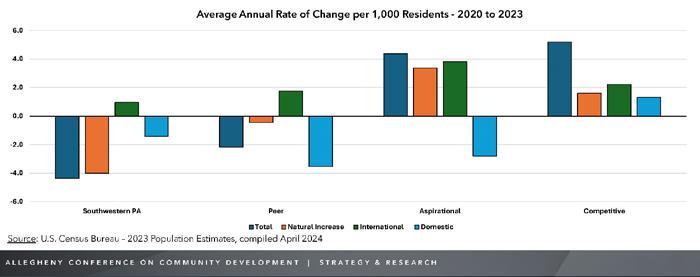

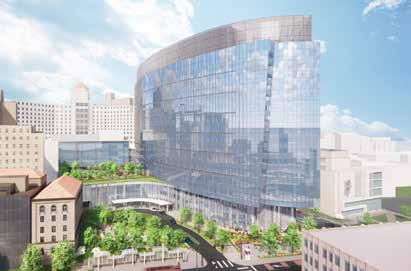












59.7 percent year-over-year and industrial, which slipped by less than $7 million.
Commercial real estate activity improved further in the second quarter, although higher borrowing and construction costs continued to limit new construction. Architects with strong concentrations in office design report increased activity in test fitting for new space, a sign that tenant leverage remains strong and tenant improvement construction will be a stronger sector of the market through 2025. Market fundamentals for multi-family continued to improve, although financing and costs remain obstacles to a flood of new construction from the unusually large pipeline of entitled projects.
The most intriguing sector is industrial property. Although there remains a significant chunk of vacant space that was delivered within the past 12-to-18 months, demand for industrial space is growing rapidly again. In early May, Amazon announced it had leased 15 million square feet nationwide and was aggressively looking to add to its footprint following two-plus years of scaling back. Industrial real estate brokers are cautiously predicting an uptick in demand that could match the high absorption levels of 2021, which would result in the need for more speculative construction in Western PA. Another surge in demand for data centers is also pushing industrial development to be more active, despite the challenging cost environment.
Industrial development is an area that could also see stimulation as soon as 2025 from Gov. Shapiro’s economic development initiatives. Pennsylvania’s $500 million Strategic Investments to Enhance Sites (SITES) has begun to roll out. One of the first SITES grants in the governor’s $235 pilot program was announced on May 9 at the site of the former Keystone Concrete Pipe plant in Hempfield Township, just northeast of Greensburg. A $2.5 million SITES investment will clear the way for an industrial park of 13 buildings, which is expected to be ready for vertical construction within three years. RIDC also received $2.3 million
in SITES funding for further development of the Carrie Furnace property.
Construction of healthcare facilities continues to be influenced by the challenging business environment for operators. Southwestern PA regional hospital systems reported operating losses for the first quarter, with Pittsburgh’s largest healthcare provider, UPMC, experiencing expenses in excess of income for the fifth consecutive quarter. Allegheny Health Network (AHN) also reported a revenue deficit, albeit a smaller one than a year ago. UPMC bid a flurry of clinical and infrastructure projects as the second quarter began, but all were smaller projects. The financial pressures will limit capital spending for UPMC and AHN in the 2024-2025 fiscal year.
AHN moved forward with its two major capital projects. Rycon Construction was selected for the $140 million new South Hills hospital to be built at the Canonsburg Hospital campus in North Strabane Township. AHN selected the Gilbane Building Co./Massaro Corp./MBM team as construction manager for its $450 million tower for the Cardiovascular Institute at Allegheny General Hospital. Design development is underway on the AHN South facility, which is scheduled to get underway in early 2025.
Construction of public facilities continued to be boosted by funding from the American Recovery Plan Act (ARPA) and the Bipartisan Infrastructure Law (BIL), although there is growing evidence that funds from the BIL are not flowing to projects as intended. In the bid market there is a bifurcation in the results of public education and infrastructure projects compared to the municipal government projects. The market for the latter has been virtually nonexistent until ARPA funding appeared in 2022 and 2023. A majority of the projects bid since then for municipal buildings, police and fire stations, or public works facilities have been significantly over budget. That has resulted in re-bidding of reduced scopes or cancelling projects. In the K-12 and highway markets, however, owners and designers appear to have adjusted their budget expectations to the market realities. Fewer projects bidding this past winter/ spring came in over budget than the previous two years.
Pittsburgh’s economy produced roughly 11,000 new jobs through April compared to a year earlier, even though seasonallyadjusted non-farm employment declined by 1,000 jobs from March to April. The May 29 report from the Department of Labor showed an increase of 13,900 in the civilian labor force in the seven-county metropolitan area. Despite the larger workforce, unemployment declined to 3.2 percent. That rate was 0.2 percentage points lower than Pennsylvania’s unemployment rate and 0.7 percentage points below the national rate.
The Census Bureau released its 2023 population estimates in mid-May, which showed that metropolitan Pittsburgh’s population declined slightly since the pandemic. The sevencounty metro area, which excluded Lawrence County, saw a decline of 35,000 people from April 1, 2020 to July 1, 2023.
Home price appreciation jumped to 9.3 percent year-over-year in Pittsburgh during the first quarter. Source: Redfin.
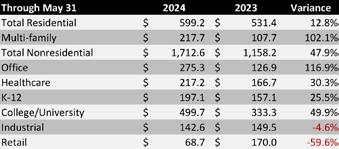



The population fell 9,807 during the past 12 months. Below the headline, however, were some interesting trends.
Virtually of the loss was the result of a natural decline, the number of deaths exceeding births. Like in the rest of the U.S., the birth rate in Pittsburgh has fallen significantly during the past 30 years. In 2023, there were 22,535 births in metro Pittsburgh, 30 percent fewer than in 1995, which was the last year births exceeded deaths in Pittsburgh. The number of deaths in the region averaged around 31,000 annually since that time (It was 31,414 in 2023.) This trend is amplified in the micropolitan census, which showed a greater
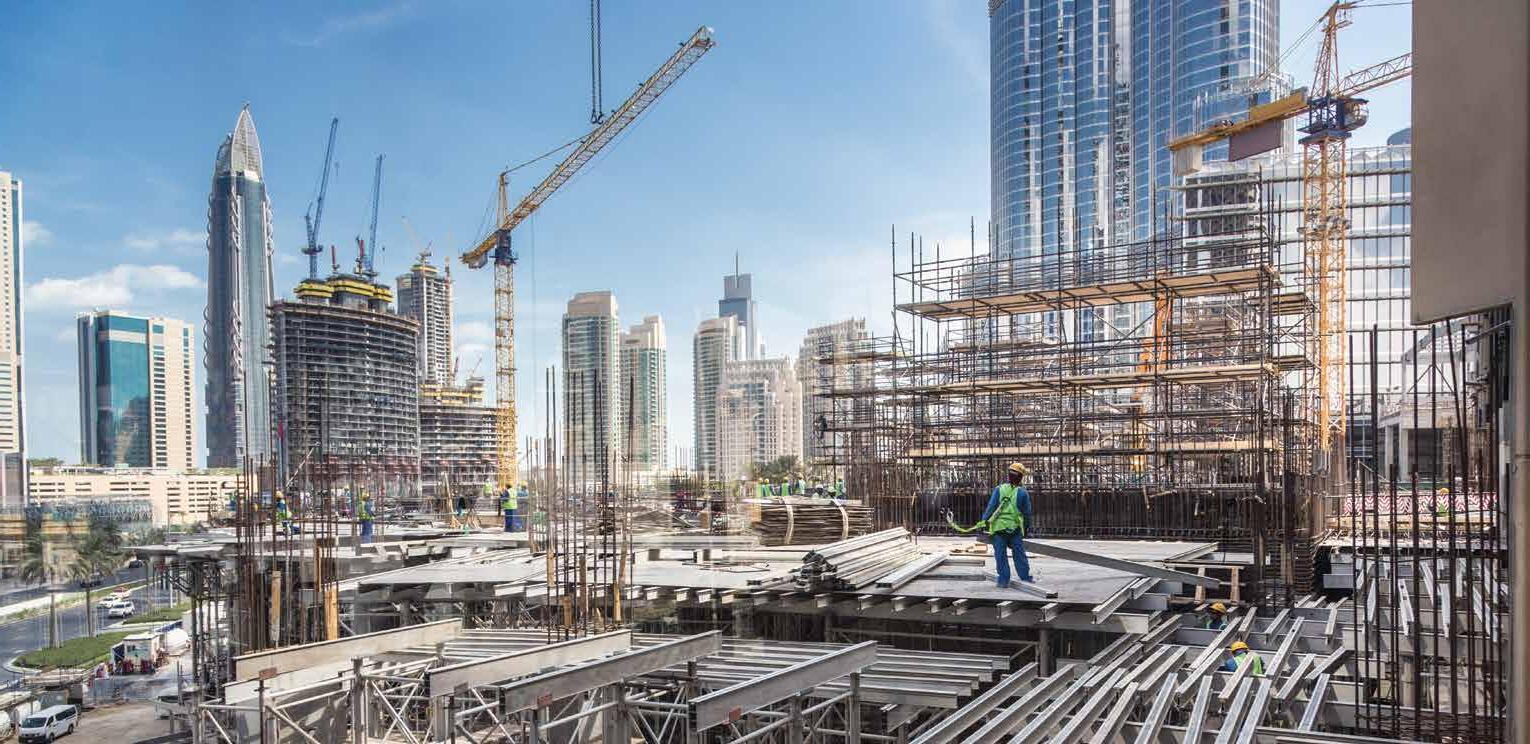


Source: Tall Timber Group

565 Callery Road
Cranberry Township, PA 16066 (724) 538-8227
Angela Wentz, Executive Director angie@asawpa.org

BUILDING ABOVE AND BEYOND

Go beyond. Repeat.
Trust your next construction project to PJ Dick.


NATIONAL MARKET UPDATE
Economic growth in the U.S., as measured by real gross domestic product (GDP), slowed in the first quarter. The economy grew by an annualized 1.3 percent in January-March, compared to the fourth quarter of 2023. A decline in exports and inventories dragged the growth rate below expectations. Real consumer and business fixed investments grew at an annualized rate of 3.0 percent.
An analysis of the major components of GDP reveals some durable trends that can be useful in assessing the path of the economy for the remainder of 2024.
Not surprisingly, the growth was driven by consumer spending. Despite sentiment that has been largely negative about the economy since the pandemic, consumers continue to spend at rates that suggest improving household finances. Consumption accounted for 1.34 percentage points of GDP growth in the first quarter. The other constant was business fixed investment, which accounted for 0.57 percentage points (up slightly from 0.5 percentage points in the last quarter). Business investment has been positive and mainly range-bound near 0.5 percentage points for more than five quarters. The more volatile components of GDP were negative in the first quarter. Net exports subtracted 0.9 percentage points and inventories dragged GDP down by 0.45 percentage points. Both were positive in the last quarter. Government spending slowed in the first quarter to add 0.23 percentage points.
The potential bad news for the economy is that the trend
for both business and consumer spending is expected to be downward for the next six months. Consumers have spent through excess savings and stimulus, and wage increases have fallen back to roughly the rate of inflation. Both real disposable income and consumer expenditures fell by 0.1 percent from March to April, according to the May 31 report from the Bureau of Economic Analysis. For businesses, there is already significant evidence that the slowdown in spending that typically accompanies a presidential election year has begun. While exports, inventories, and government spending may offset slowdowns in business and consumer spending, the Blue Chip Economic Indicators forecast is for GDP growth to be 1.5 percent by the fourth quarter of 2024.
The most recent months’ Job Openings and Labor Turnover Survey (JOLTS) also suggests that the economy is finally cooling off the labor market. The number of open jobs has fallen from a high-water mark of 7.5 percent in mid-2022 to five percent. Likewise, employers report that new hires have fallen from 4.5 percent to 3.5 percent during the same period. The number of workers reporting that they had quit jobs declined to two percent, while layoffs remained stable in the one percent range since the rollout of vaccines in mid2021. A decline in corporate profits during the first quarter is a potential source of increased layoffs in the second half of 2024.
Job creation is similarly slowing, although the data is mixed. The last Employment Situation Summary on June 7 showed employers added 272,000 jobs, well above the 185,000 gain that was expected. That headline was from the Establishment Survey, one of the two surveys used for the jobs report, which queries businesses. The other survey, the Household Survey, queries individuals (as the name suggests) and that survey for May showed a loss of 425,000 jobs. It is from the Household Survey that the unemployment rate is derived, which is why the May Unemployment Situation Summary showed unemployment growing by .1 percentage point to 4.0 percent. The increase in unemployment came despite a decline in the workforce participation rate.

There are two explanations for the growing disparity between the two underlying surveys. One is the dramatic decline in survey participation rate, which has fallen from 70 percent pre-COVID to 30 percent. Such a precipitous decline is likely to decrease the reliability of the survey. The other salient explanation is what the Bureau of Labor Statistics refers to as the “birth-death adjustment,” an estimate of the businesses opening and closing that is meant to compensate for data that the two







































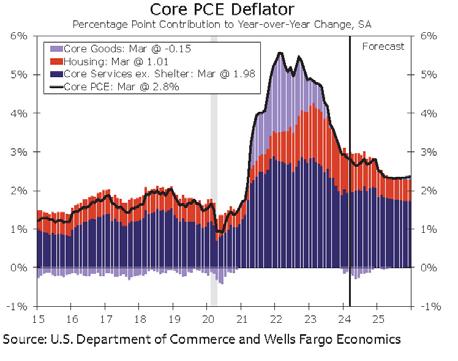
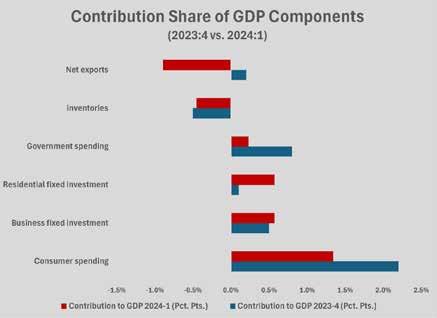
Source: Bureau of Economic Analysis, Haver Analytics
employment surveys miss. This birth-death estimate has been unusually high in recent months and accounted for 231,000 of the 272,000 jobs gained.
Ahead of the June 7 jobs report, payroll firm ADP released its National Employment Report for May, reporting that private employers added 152,000 jobs. Almost all the gains were in the services sector, with goods creating jobs growing only by 3,000 jobs. Construction employment grew by 32,000 jobs while manufacturing dropped 20,000 workers and natural resources/mining employment fell by 9,000 jobs.
ADP reported that pay increased 5.0 percent year-over-year for private sector employees.
The Labor Department reported on June 6 that 229,000 people filed initial unemployment claims last week. Long-term unemployment claims rose 2,000 to 1.792 million. Layoffs declined 1.5 percent from April to May, and were 7.6 percent lower through five months compared to the same period in 2023.
The Institute for Supply Management’s Manufacturing Purchasing Managers’ Index (PMI) slipped slightly in May, remaining range-bound between 47 and 50. The PMI is comprised of data from over 400 purchasing executives in the manufacturing sector, representing 20 industries, in all 50 states. The report monitors activity in production, new orders, supplier deliveries, inventory, employment, prices, exports and imports. It also examines lead times and commodity information. PMI readings below 50 represent contraction. Over the past year PMI has fallen six times and risen six times compared to the previous month, but the reading has been above 50 only once since October 2022.
Such an extended period of contracting activity should precede a recession; however, the Services PMI was 51.8 in May, the tenth consecutive month of expansion.
April’s housing report reflected several trends that should continue until interest rates move lower. Permits for single-family homes fell but new construction starts were more than 25 percent higher year-over-year. Builders started 1.03 million single-family homes in April. Builders reported slower traffic since 30-year mortgage rates crept back above seven percent but have been offsetting the higher rates with price cuts and mortgage buy-downs that are making new construction more affordable than many existing homes for sale.
Sales of new homes are starting to slow because the inventory of existing homes for sale; however, existing home inventory remains supportive of new construction. Sales fell by 4.7 percent in April, in part due to mortgage rates rising above seven percent again, but new construction demand will outpace supply throughout 2024. The average time a completed home stayed on the market fell again in April to 2.3 months. That compares favorably to the 3.6 months the average new home stayed on the market from 2012-2019.
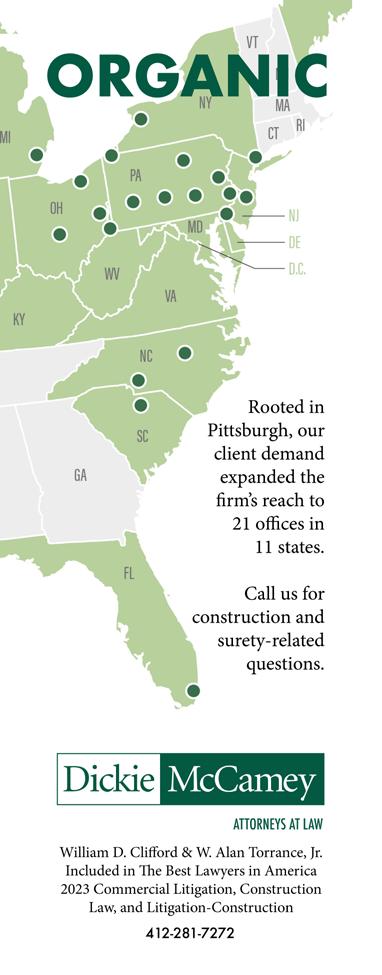
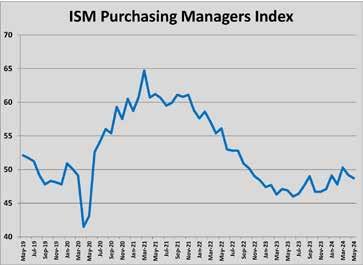
The Manufacturing PMI stayed below 50 again in May.
Source: Institute for Supply Management.
Multi-family starts fell further to a 329,000-unit annualized rate, although permits for multi-family units jumped more than 30 percent in April to a 464,000-unit pace. April’s multi-family construction was 20 percent off the pace of February 2024 and 23.3 percent lower than the volume in April 2023. CoStar reports that multi-family net absorption was 109,000 units in the first quarter, the highest level in nearly three years. Developers report that demand for multi-family is still strong, but the higher costs of borrowing and construction are keeping projects from being profitable enough to proceed.
Nonresidential construction spending continued at a slower pace again through April, falling for the second consecutive month and the third month in four in 2024. Nonresidential spending declined 0.3 percent from March to April, bringing total construction down 0.1 percent.
Head winds in commercial construction offset the stronger spending in manufacturing buildings during the first quarter. Retail construction cooled in response to the anticipated slowdown in consumer purchases. New commercial construction starts of all types slowed to 52.1 million square feet in the first quarter, roughly 25 percent of the peak for new construction in the third quarter of 2022. Construction of power and energy projects also slowed. Overall, the year-over-year growth in nonresidential construction pulled back below 12 percent. That contrasts to year-over-year growth of 24 percent a year ago.
Architects continued to see weakness in design activity through April. The American Institute of Architects’ Architectural Billings Index (ABI) remained negative for the ninth consecutive month in April, measuring 48.3. April’s month-over-month decline marked the 15th month of lower billings in the 19 months since the ABI fell below 50 in October 2022.
For the balance of 2024, the U.S. economy will be slowed by the lingering impact of higher borrowing costs, lower personal savings, and the uncertainty surrounding the presidential election. Inflation looks to be less of a drag, although there will continue to be persistently higher prices on gasoline, services,
and insurance. The Federal Reserve Bank’s favored measure of inflation, core personal consumption expenditures (PCE), slowed to 2.7 percent year-over-year in April, making it more likely that core PCE will fall below the forecast of 2.5 percent at year’s end.
Bond markets have increased the likelihood of a rate cut in September to roughly 70 percent, and at least one more 0.25 percentage point cut is expected in 2024. Assuming this trajectory continues through the third quarter, long-term rates (like residential and commercial mortgages) should fall below resistance levels in 2025. The Federal Reserve has announced a slowing in the reduction of Treasury bonds in its portfolio, which will remove another upward force on rates. The consensus forecast is for the 10-year Treasury yield to fall to the 3.75 percent range over the next 12 months. That should bring long-term mortgage rates below six percent again.
Lower mortgage rates will not cure all economic ills. The sea change in office occupancy and in downtown commercial activity will linger and require re-balancing of supply over a longer period of time. Consumers will likewise need to rebalance spending and debt levels. Lower rates that are stable will offer certainty about property values and development costs that will release projects for which there is demonstrated demand. A rate environment in which permanent commercial mortgages are closer to 5.5 percent should unlock multi-family and industrial development, both of which are experiencing pent-up demand growth. A similar environment for residential mortgages should unlock existing homes with sub-four-percent mortgages that would have been on the market except for the high rates. Lower rates will also mean that inflation has returned to its long-term level near two percent, another relief for the economy. The path to that lower rate environment seems clear, but it will take another 12 months or so to get there. BG





WHAT’S IT COST?
With the exception of a handful of materials, escalation in the cost of construction materials and products has stabilized and/or retraced slightly; however, contractors are reporting that unusually higher costs for non-material inputs – fuel, labor productivity, and insurance, for example – are exerting upward pressure on project costs.
Increased losses due to natural disasters are putting pressure on insurance companies to raise rates on all categories of business insurance. And for construction, a slight but significant increase in surety defaults and a dramatic increase in the cost for insurers to complete projects in default is pushing premium costs higher for construction-related firms.
The producer price index (PPI) for new nonresidential building construction – a measure of what contractors report it would cost to complete a specific set of buildings – has been slightly lower year-over-year since the beginning of 2024. The higher material input costs during the first quarter, along with higher non-material costs, suggest that escalation will climb higher as the year unfolds. Through May, however, the Bureau of Labor Statistics (BLS) report on changes in PPI for specialty contractors shows prices have stabilized. Among the four major specialty trades BLS tracks – concrete, roofing, plumbing, and electrical – none were up more than 0.1 percent from April to May. Only plumbing contractors were reporting a year-over-year increase of at least 1.0 percent. Prices for electrical work put in places were down 2.3 percent year-over-year.
At the regional level, the impact of escalation will be magnified, or mitigated, by competitive pressures, labor availability, and productivity.
The Institute for Supply Management reported in May that significant shortages in the supply of certain items were causing unusual delays. The most notable include brass fittings, availability of contractors and labor (three months each), electrical components (four months) and equipment, switchgear, and transformers (two months). These supply chain delays drive costs higher for specialty contractors’ general conditions, productivity, and overhead. Specialty contractors generally absorbed these higher costs during and immediately after the pandemic but are compensating for the supply problems that continue.
At the macroeconomic level, inflation eased again in May. The measures of consumer prices (CPI) moved ahead 0.1 percent from April to May and 3.3 percent year-over-year. Core CPI, which excludes energy and food prices, was up 3.4 percent compared to May
2023 and 0.2 percent from the previous month. All measures of inflation were cooler than expected.
For materials integral to construction, declines in diesel fuel and steel were keeping material inputs lower, although steel products rallied slightly in May. That rally is expected to be short-lived and the change in steel year-over-year is negative by double-digit margins. Diesel fuel was off 20.3 percent from April to May and 13.1 percent year-over-year. Lumber products were down 1.5 percent in May and 2.8 percent for the year. Concrete products and cement prices were flat from April to May; however, those prices were between 3.4 percent and 6.8 percent higher year-over-year. The other basic construction material seeing escalation above the three percent range is copper, which saw prices for mill shapes jump 4.5 percent and scrap spike 9.8 percent in May. BG
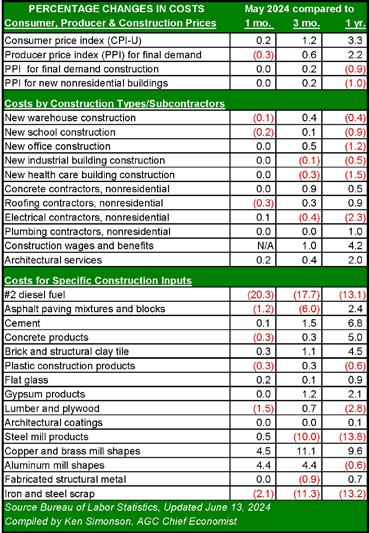









Long before Shell Chemicals, UPMC, or the Allegheny County Airport Authority contemplated investing billions on new facilities, the mega-project in the pipeline in Western PA was an environmental project, Allegheny County Sanitary Authority’s (ALCOSAN) wet weather equalization program. Throughout the 1990s and 2000s, construction that had an environmental purpose – be that waste and water treatment, energy efficiency, or a reduction in carbon emissions – was poised to be one of the biggest sectors in the industry.



ALCOSAN’s North End Plant Expansion under construction. Photo by Mascaro Construction.
What happened to that wave of environmentallyfocused construction? For the most part, it continues to this day. Unlike a retail or housing boom, the increase in construction related to improving the environment was more diffuse and more difficult to isolate as its own boom. For certain, there have been trends within the wave that have been identifiable. LEED certification was a driver of green building projects. Government funding or incentives have ushered in smaller waves of renewable energy or clean water projects. And a reemphasis on the environment in Western PA pushed major investments over the finish line for ALCOSAN and Pittsburgh Water and Sewer Authority (PWSA).
As the mid-2020s approach, the potential for another higher plateau in environmental investment looms as a new wave of construction to replace the demand from the mega-projects of the past decade. Funding from pandemic era bipartisan federal legislation is set to spur public and private investment in clean energy, clean water, and a cleaner environment. Like with most government initiatives, there are complications that threaten to derail or divert the funding from its purposes. State and local funding is becoming more tenuous. The average taxpayer’s focus on environmental improvement has wandered in the face of more immediate “kitchen table” issues like inflation or housing affordability.
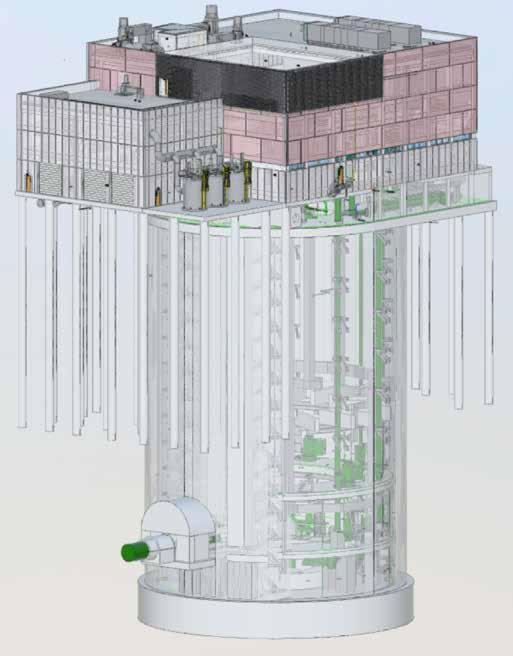
Rendering of the southeast façade and underground facilities of ALCOSAN’s $200 million wet weather pump station, which will bid during the first quarter of 2025. Rendering by Brown and Caldwell. Use courtesy ALCOSAN.
These current challenges to the environmental market are different, but also similar, to challenges that have always faced that market segment. There has never been enough money available to solve the post-World War environmental problems. As each year gets warmer, as each summer and winter storm season get more severe, the public will for protecting the environment grows, even as the opportunities for finding common ground seem to dwindle. The odds of a large-scale, integrated public solution to our long-term environmental challenges seem to be dwindling; however, for the balance of the decade at least, the funding and the will exists to drive more construction.
Treating Our Water and Waste
Over the past five years, there has been a marked increase in the number and scope of regional waste and water construction projects. This surge was both predictable and overdue. The demand for waste and water construction is a result of life cycle and market considerations that would have boosted construction a decade or so earlier were there a greater availability of funding.
The Environmental Protection Agency (EPA) estimates that 75 percent of U.S. citizens are connected to the 16,000 treatment
plants in operation nationwide today. The majority of those facilities exist because of the Clean Water Act of 1967 (CWA), the reauthorization of the Water Pollution Control Act of 1972, and the federal and state funding that flowed in support of the CWA. When Congress passed the CWA, construction of treatment plants boomed for a decade until funding and regulatory problems at the EPA forced major changes early in the Reagan administration.
In the time since that first surge in treatment plant construction, few new plants have been built in Western PA and modernization/expansion has been difficult because funding such projects would have come from the municipal authority’s customers. Several factors are behind the improved conditions for waste and water projects in recent years.
Built in the 1970s, most suburban or rural treatment plants were designed to have 40-to-50-year life cycles. Even in areas where there has been little or no population growth, like metro Pittsburgh, the amount of water requiring treatment has increased. Existing plants have become obsolete and are increasingly inadequate for the supply of water and wastewater that they are treating. The EPA estimates that 15 percent of U.S. plants are beyond their maximum capacity. That estimate is low in areas with older treatment plants.
A second factor is the adoption of higher standards for treated water and wastewater. Since the passage of the
CWA, state and federal agencies have identified numerous chemicals, heavy metals, plastics, and other pollutants that are present after primary treatment occurs. Many elements not known to be harmful previously have been identified for elimination from municipal water systems. The EPA’s Effluent Guidelines Program Plan 15 was rolled out in January 2023 to include additional organic and inorganic pollutants, especially polyfluoroalkyl substances (PFAS), the so-called forever chemicals.
The third driver of new construction has been the improved efficiency of plants. Water and wastewater treatment plants are large energy consumers. Electricity costs account for 25 to 40 percent of the operating costs of a plant. Improvements in technology for pumps, motors, and treatment equipment provide life cycle cost savings that can fund improvements. Treatment plants are often better sites for renewable energy installations than most commercial buildings. And modernizing treatment equipment can provide increased capacity without requiring expansion or new construction.
Since 2019, there have been wastewater and water treatment facility improvement projects that were valued at more than $25 million at an increased frequency. The municipal authorities have been varied, with projects in more than a few locations that are not experiencing population or economic growth. Among those locations with projects over $25 million that are under construction or recently completed are Center

RELIABLE PERFORMANCE - INSIDE AND OUT CONTRACT GLAZING








Township in Beaver County, which invested more than $90 million, Canonsburg-Houston, Rochester, Allegheny Valley in Harmar Township, Hampton Township, New Kensington, Municipal Authority of Westmoreland County in Connellsville, Youghiogheny Treatment Plant in North Huntingdon Township, Clairton, and the Mon Valley Sewage Authority plant in Donora.
These projects were in addition to the major projects undertaken by ALCOSAN and PWSA, specifically the $100 million North End, $87 million East Head Works, $98 million CSO Bypass Disinfection, and the $32 million Environmental Compliance Facility at ALCOSAN, and PWSA’s $39 million Highland Reservoir Pump Station.
The pump station at Highland Reservoir is the fourth major improvement made at the site as part of PWSA’s 2021 Water Reliability Plan. That plan, which will invest $470 million in plant and underground construction, is roughly one-third of the way completed or under construction, according to Julie Asciolla, industry relations manager at PWSA. Among the other improvements at the Highland Reservoir was a replacement of the liner and cover, which was the largest such project in the U.S. in 2022. The century-old reservoir was drained and cleaned, and a new liner, floating cover, and supplemental equipment were installed. PWSA estimates that the project extended the useful life of the reservoir by an additional 25 years.
This current wave of waste and water projects doubled the amount of construction in that sector since the 2010s. After peaking at above $275 million per year in 2022 and 2024, waste and water treatment plant construction will surge above $1 billion in 2025 and beyond with the construction of the three river tunnels that ALCOSAN has in the pipeline.
Construction of water and wastewater treatment plants are not getting a boost from the BIL. The bipartisan legislation, which passed in 2022, has been slow to roll funding out to projects, with less than $30 billion of the $550 billion distributed during the first two years. The Congressional Budget Office expects to see funding escalate during the next few years to a 20272028 peak; however, the legislation earmarks less than $60 billion for clean water projects over the life of the funding. Slightly more than $20 billion is identified for environmental remediation projects.
Green Building and the Circular Construction Economy
When the first organizations to address green building were formed three decades ago (including Pittsburgh’s Green Building Alliance [GBA] in 1994), their mission was to address the performance of the built environment. As the ideas and initiatives for improving energy and environmental performance began to gain momentum, however, the focus of green building advocacy was on large capital projects. Large, well-publicized projects, like the David L. Lawrence

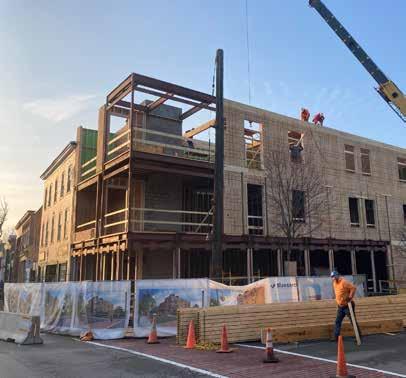

Convention Center or The Tower at PNC Plaza, amplified the advocacy message and acted as proving grounds for the energy-efficiency and environmental concepts.
The emphasis began shifting to the built environment as the 2030 Challenge gained acceptance. Begun in 2012 with 2023 Districts in Seattle, Cleveland, and then Pittsburgh, the 2030 Challenge seeks to reduce the environmental impact of existing buildings across multiple metrics. Pittsburgh’s 2030 District, the largest of the 23 districts in North America, seeks to reduce the carbon emissions of the more than 540 buildings within its boundaries by 50-to-65 percent by 2030, and go to zero by 2040.
On May 22, GBA announced the results of the Pittsburgh 2030 District for the year 2023. The 2030 District currently includes Downtown, the Oakland business district, most of the commercial buildings on the North Side, and the Strip District. It also includes the redevelopment sites in the Lower Hill District that are under construction or unbuilt. During 2023, buildings in the 2030 District reached a cumulative reduction in carbon emissions of 48 percent. Energy usage was reduced by 22.3 percent. Water usage was reduced by 39.4 percent.
Leadership in Energy and Environment Design (LEED) was the benchmark for how a construction project would perform once completed. As LEED certification has slowed – the number of projects LEED-certified in Pittsburgh has declined by half
annually since a 2014 peak – an emphasis on existing building operations has increased. The emphasis on the built inventory is well placed, since buildings produce roughly 39 percent of all greenhouse gases. In Pittsburgh, the 2030 District encompasses 86 million square feet. A quick glance at the Pittsburgh 2030 District map shows that most of the buildings in the densest neighborhoods are committed to the challenge. The opportunity for expansion exists in the Strip District and Lawrenceville.
An idea that is gaining steam in construction is the adoption of waste recycling. By expanding the concept of recycling to include the intentional reuse of waste materials throughout the supply chain – including all manufacturing – the construction industry can move away from its well-earned reputation as an industry that consumes raw materials at one of the highest rates. Construction recycles somewhere between one-third and 40 percent of the waste associated with manufacturing and building projects. That leaves plenty of room for improvement.
Globally, the idea of recycling waste is a foundational principle of what is called the “circular economy.” The market for businesses involved in the circular economy is already large, estimated at $500 billion annually worldwide in 2022. The European Union estimates that growth in business in the circular economy will grow by an additional $660 billion by 2025. Construction has historically been a linear economy, consuming raw materials and resources in the process of
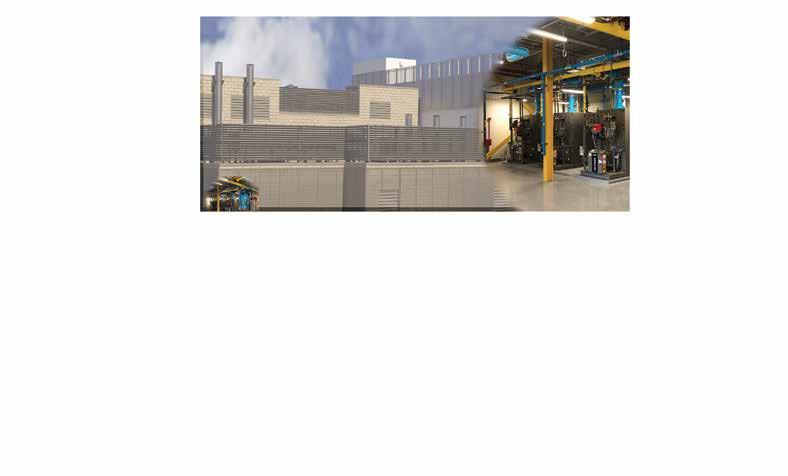

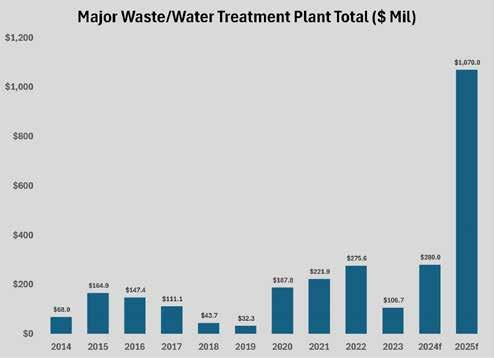
building, and then disposing the waste. Changing that model will require increasing the use of recycled or reused materials wherever possible.
For construction, the circular economy would begin with the materials producers. Not surprisingly, some of the earliest adopters of a circular approach have been in the sectors that are often cited as the worst for the environment.
Cement manufacturing is the third worst-polluting industry in the world, accounting for up to nine percent of all human carbon dioxide emissions. The enormous amounts of energy and heat needed to produce cement mean that it will be difficult to significantly reduce the pollution from cement manufacturing without major advances in cleaner sources of energy and changes in the way cement is specified in concrete
Sustainability
Carbon
Indoor
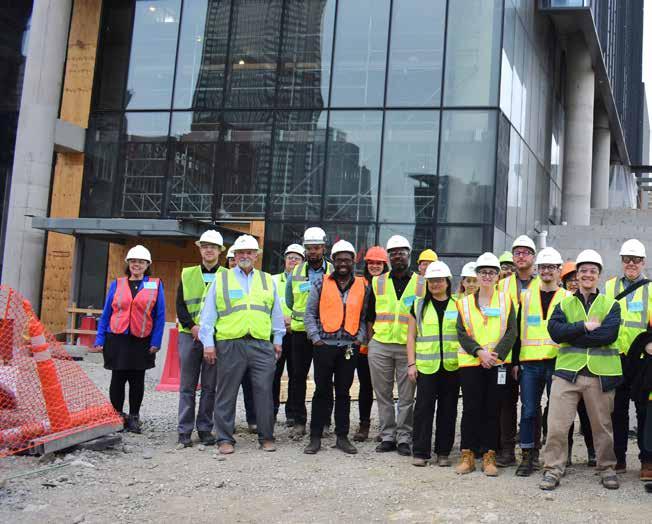
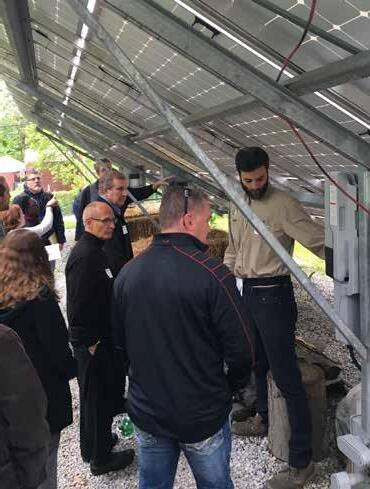
Construction of wastewater and water treatment plant projects has increased steadily since the mid-2010s and will peak during the second half of the decade with the construction of ALCOSAN’s tunnel projects. Source: Tall Timber Group, ALCOSAN, PWSA.
Solar Panel Demonstration
admixtures. But the cement industry is adopting circular models for waste management.
Cemex, the third largest cement producer in the U.S. last year, recovered 95 percent of its waste for reuse or recycling at its 11 U.S. plants. The largest producer in the U.S. and worldwide, Holcim, recycles end-of-life and waste materials in its own manufacturing processes. Holcim diverted 50 million tons of waste from landfills in 2023 and is on track to reach 100 million tons by 2030.
Reduce, reuse, and recycle are the three principles of the circular economic model. At the regional level, it can be most difficult to reduce the amount of total resources that are needed to construct a building project. Most of the resources consumed on a project have been used before the materials or products arrive on site. Many of the industries that consume the most natural resources do so because the accepted methods for manufacturing require it. What local companies have control over is how much of what would be wasted is diverted from landfills to a second productive use. (For more, see Best Practice, page 53.)
Recycling of job site waste has been going on for decades on a selective basis. Pittsburgh firms like Construction Junction and Doors Unlimited, for example, process and resell building products that would otherwise be landfilled. Waste haulers have recycled metals, plastics, paper, and other commodities, depending upon market prices. Those companies have been
expanding the breadth of materials being recycled or reused to include most of what is demolished on a commercial or residential project.
Orbital Biocarbon, a Pittsburgh business that is involved in energy, water, and clean-technology solutions, is growing a circular economy application for wastewater treatment that is partly pre-recycling. (See sidebar page 28.) Orbital is attempting to disrupt the wastewater sludge removal process using a German technology that has 60 operating installations worldwide. The technology implements the full circular economy model. It reduces resources used in removing sludge and the harm that can come from it, while at the same time repurposing the sludge for other productive applications and recycling the material to produce energy and biochar.
Energy and the Environment
The passage of the Inflation Reduction Act of 2022 (IRA) was meant to kickstart the development of a wave of renewable energy projects that would help reverse the decades-long increase in fossil fuel consumption. The act included $369 billion in investments in new energy technologies.
For Western PA, the IRA and the Infrastructure Investment and Jobs Act of 2021 (BIL) offered hope that some of the advanced energy and climate research done at Pitt and Carnegie Mellon would translate into new facilities for power generation. A regional team was assembled to compete for
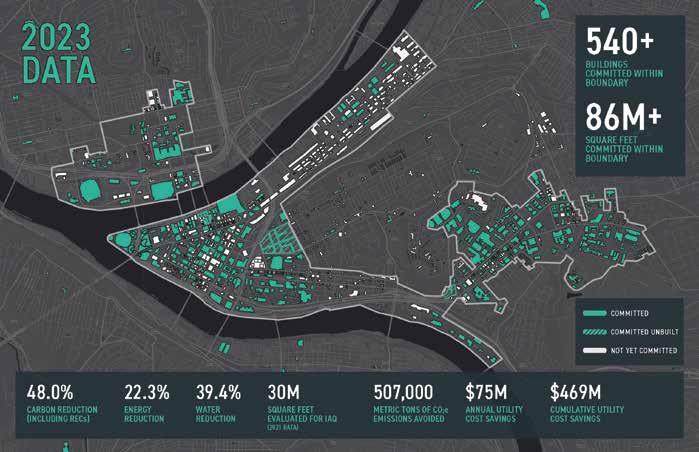
$8 billion in grants from the BIL to create a hydrogen hub in Western PA. That grant was ultimately awarded to the Appalachian Regional Clean Hydrogen Hub (ARCH2) team based in Morgantown, WV.
ARCH2’s plans primarily involve making use of the abundant natural gas supply in the Appalachian basin to make “blue” hydrogen, as opposed to creating “green” hydrogen through electrolysis using renewable energy sources. As laid out in its very preliminary plans, ARCH2 was going to develop a handful of major hydrogen plants in the Tri-State region, although none in Western PA. As part of its plans for converting natural gas to hydrogen, ARCH2 planned to construct an alternative aviation fuel plant, tentatively in Greene County. Recently, KeyState Energy announced its own plans for an alternative aviation fuel plant, in partnership with CNX and Pittsburgh International Airport.
As part of the federal granting process, however, there are requirements for extensive and transparent community reviews for the plans. Those review requirements have opened the doors to stiff opposition to any plans to make blue hydrogen.
There are other requirements tied to the IRA and BIL grants that are proving to be problematic. The production tax credits that are key incentives for hydrogen hub investment are in danger of being wiped out by countervailing regulations put in place by the Treasury Department and Internal Revenue
Service. Most troubling are rules that would eliminate the tax credit if fossil fuels were used as a source for hydrogen production. This rule allegedly pushed CNX to drop out of an ARCH2 project partnership. As of late June, Senator Robert Casey was leading a push to revise the Treasury regulations so that fuel sources like natural gas could be used in hydrogen projects that qualified for the tax credits that make the projects feasible.
Likewise, the timelines set for energy producers to meet federal requirements are at odds with how the electricity grid manager, PJM Interconnect, currently operates.
To qualify for the grants and tax credits, a green hydrogen project must use a green energy source that is new and commissioned within 36 months prior to use in the hydrogen project. But PJM has a moratorium on new interconnect permits and its approval process takes at least two years. Most potential providers report that the approval process is years longer than that. A potential hydrogen producer that wants to use a green energy source could easily find itself in a Catch-22 where it is required to use the most recently constructed source, one that cannot get approval from PJM to connect.
The unwieldy process of development for hydrogen plants, as well as the high cost, may help spark innovations in the hydrogen sector. Peoples Gas recently announced it was partnering with H Quest to develop small modular


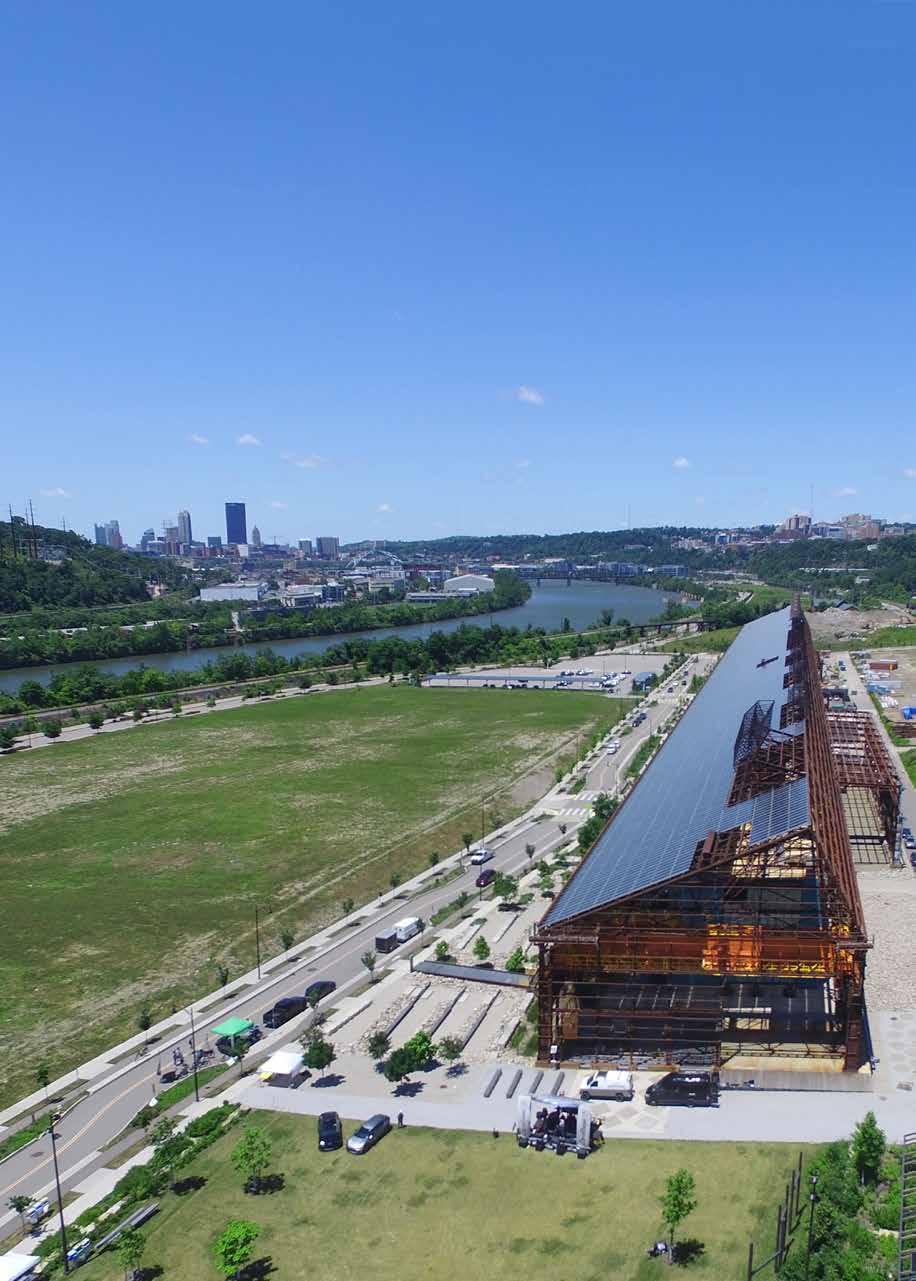

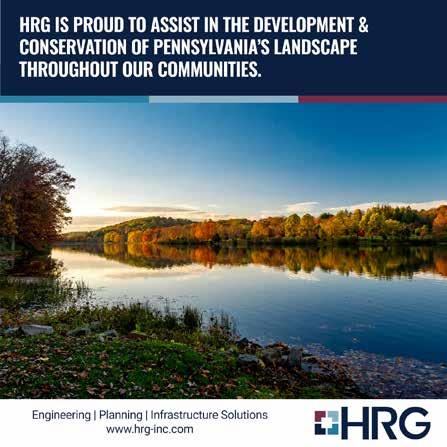



Avison Young creates real economic, social and environmental value as a global real estate advisor, powered by people. Our integrated talent realizes the full potential of real estate by using global intelligence platforms that provide clients with insights and advantage. Together, we can create healthy, productive workplaces for employees, cities that are centers for prosperity for their citizens, and built spaces and places that create a net benefit to the economy, the environment and the community.
What is in the Environmental Pipeline?
Aside from the projects detailed above, the largest construction opportunities in the pipeline are with the two major utilities in the city, ALCOSAN and PWSA. Both are in the middle of major capital programs, which still have projects to be built.
For PWSA, the nearest major opportunities are the Aspinwall Pump Station, the Bruecken Pump Station, and the Clearwell Bypass. The three projects are all in the latter stages of design, with construction documents set to be released for bidding in September/October.
The largest of the three projects is the Bruecken Pump Station, which is estimated to cost $80 million. PWSA plans to build a new pump station and a related building to replace the existing 90-year-old facilities that sit along Allegheny River Boulevard opposite the Aspinwall treatment plant. At the Aspinwall plant, new facilities will be built to replace the 1910-era pump station. That project is estimated to cost $53 million. PWSA will also invest $26 million to create a bypass for the 100-year-old drinking water clearwell at the Aspinwall facility.
Once the three projects bid later this year, only two more major projects from the Water Reliability Plan will remain, Aspinwall and Fox Chapel Interim Feed and the $57 million Clearwell Replacement. The total Water Reliability Plan is expected to be completed by 2028 or 2029. Between now and then PWSA plans to spend a total of $1.7 billion, much of which will be invested in underground infrastructure. That capital spend should average more than $430 million annually from 2026 through 2028.
ALCOSAN has the most expensive pieces of its Wet Weather Equalization Plan, the Ohio, Allegheny, and Monongahela River tunnels, still in the design stages. The tunnels will be, respectively, 4.9 miles, 6.2 miles, and 5.4 miles long. Each will be 18 feet in diameter. The Ohio River tunnel will include 1.1 miles of 14-foot diameter tunnel. The estimated cost of the Ohio River tunnel is $750 million.
Working with tunnel program manager, Jacobs, ALCOSAN expects to take bids on the Ohio River tunnel in the fourth quarter of 2024. Design will commence on the Allegheny River tunnel in 2025, and on the Monongahela River tunnel in 2026. Construction will continue on the three tunnels until 2036.
Approximately 60 percent of the cost of the tunnel projects will be the boring and related activities of the specialty tunnel contractor,
New Technology Improves Sludge Removal
The aptly named sewage sludge is the byproduct of the municipal wastewater treatment process, which results from the separation and treatment of the liquids and solids in the wastewater stream. These biosolids have been sufficiently treated to remove pathogens so that the sludge may be removed and applied to land or treated further by drying or pressing. For municipal wastewater authorities, sludge removal is expensive. For the community at large, sludge removal and application present other problems, including the risk that the satisfactory level of treatment does not eliminate harmful pollutants. For environmental protection agencies, that risk requires further regulation.
A group of local environmental entrepreneurs are deploying advanced technology for treating the dried sludge to create a profitable business opportunity. Orbital Biocarbon uses a carbonization technology developed by German-based Pyreg to super heat the sludge. The resultant products have a viable posttreatment market and the carbon that is reduced or sequestered as a result has a value through the available carbon tax credits.
“We are working with the various municipalities to develop projects, raise capital, orchestrate the operation and maintenance of these plants, as well as assisting in the off-take operation,” explains John H. Day, president and principal at Orbital Biocarbon. “Our business is at the crossroads of waste management and recycling. We produce renewable energy and a biochar commodity which has various and use markets.”
North Side-based LLI Engineering is a local engineering partner with Orbital Biocarbon. Jamie White, LLI’s president and CEO, explains that the increased understanding of the challenges associated with digesting or disposing of sewage sludge ratcheted costs higher, creating the opportunity.
since the tighter regulations. Municipal waste authorities in PA have seen costs rise, which places a disproportionate burden on the smaller rural and exurban authorities that comprise the bulk of the treatment facilities.
“Major systems have the capacity to digest the sludge from the plant. Smaller plants in areas outside of urban areas do not have the infrastructure in place to digest the material on site. In those cases, the sludge is either dewatered and landfilled or hauled to a major plant for treatment,” says Day.
Orbital Biocarbon’s plants heat dried sludge in a Pyreg oven. The process creates a high-quality, carbon-stable biochar for fertilizer and a synthetic gas that can be used to heat and generate electricity. Orbital’s business model is to provide turnkey services, owning and operating the plant, and harvesting the carbon credits and downstream profits from the process. Day says that there are plants that may want to own and operate Orbital’s process but almost all are pleased to have the sludge hauling problem solved at a predictable reduced cost.
“A lot of the plants in Western Pennsylvania are cash strapped. They do not want to increase fees on their customers. They can’t afford to take care of maintenance and they’re near the end of their natural lives,” notes White. “There are at least 40 or 50 plants that have to do something to improve their plants. Regulators are pressuring them to modernize. By installing one of these plants, that pressure is removed or eased.”

“Sludge can be hauled away and used as fertilizer in agriculture but in that process all of the CO2 in that sludge goes to the atmosphere. Any of the toxins in the sludge stay in it as well and are dumped on the field,” White says. “Because of that, DEP and the EPA are outlawing the use of sludge as fertilizer. In Maine, for example, all sludge has to be treated in some way before being used as fertilizer. In Pennsylvania, the sludge has to be dried out and at least partially treated. The restrictions are getting stricter each year. As a result, the hauling of that sludge is becoming dramatically more expensive for treatment plants each year.”
White notes that the cost of waste hauling in Maine has tripled
Pyreg has more than 60 plants installed globally, including one in Ephrata, PA, in Lancaster County. A typical plant is the size of three shipping containers. A Pyreg plant can be collocated at an existing treatment plant or built standalone to treat multiple municipalities.
Day is quick to point out that while Orbital’s system adds value to the municipal waste and water operators, his company’s mission has more to do with what comes out of the process than what goes into it. The byproduct gases reduce or eliminate the fossil fuels needed to operate the sludge processing system. The heat from the process destroys the chemicals of emerging concern that are present in the sludge, removing them from the environment. Day notes that 45 percent of sludge is currently land-applied, meaning that the forever chemicals in the undigested sludge would also be land-applied, an outcome Orbital Biocarbon’s process eliminates. And the biochar that is produced at an Orbital Biocarbon facility is extremely high in phosphorus, ensuring a vital fertilizing chemical does not become short of supply. BG
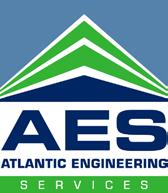




Bids will be taken in the fall for the $80 million Bruecken Pump Station. Rendering courtesy PWSA.
according to Kimberly Kennedy, director of engineering and construction for ALCOSAN. Kennedy spelled out the opportunities for regional contractors that would result from the construction of the tunnels.
“The remaining 40 percent provides opportunities for regional, local and specialty contractors for activities such as: excavation, slurry walls, secant piles, sheet piles, control buildings, trucking/muck hauling, ground modification and shaft grouting, near surface support of excavation, near surface tie-ins and structures, security, traffic control, fencing, site restoration, vents, geo-instrumentation and other miscellaneous,” says Kennedy.
In addition to the tunnels, ALCOSAN will take bids on $38 million solids thickening and dewatering improvements at its main plant in late July. In the first quarter of 2025, ALCOSAN is scheduled to advertise its $200 million Wet Weather Pump Station project, which is currently being designed by Brown and Caldwell. A Contractor and Small Business Outreach will be held August 27 for firms interested in the Wet Weather Pump Station and Ohio River tunnel.
The consent decree that required ALCOSAN to eliminate sewage overflows and greatly reduce combined stormwater and sanitary overflows dates to 2008. Since that time, ALCOSAN struggled to engineer solutions necessary to meet the consent decree that were affordable for its customers. Sixteen years later, those solutions are well under construction. PWSA also wrestled with how to afford to make necessary, but costly, improvements to its antiquated infrastructure for years. For the balance of the decade, the modernization that these two public agencies will do will fill in the gaps that the Airport Terminal Modernization and UPMC Heart and Transplant Hospital will leave in the market. BG
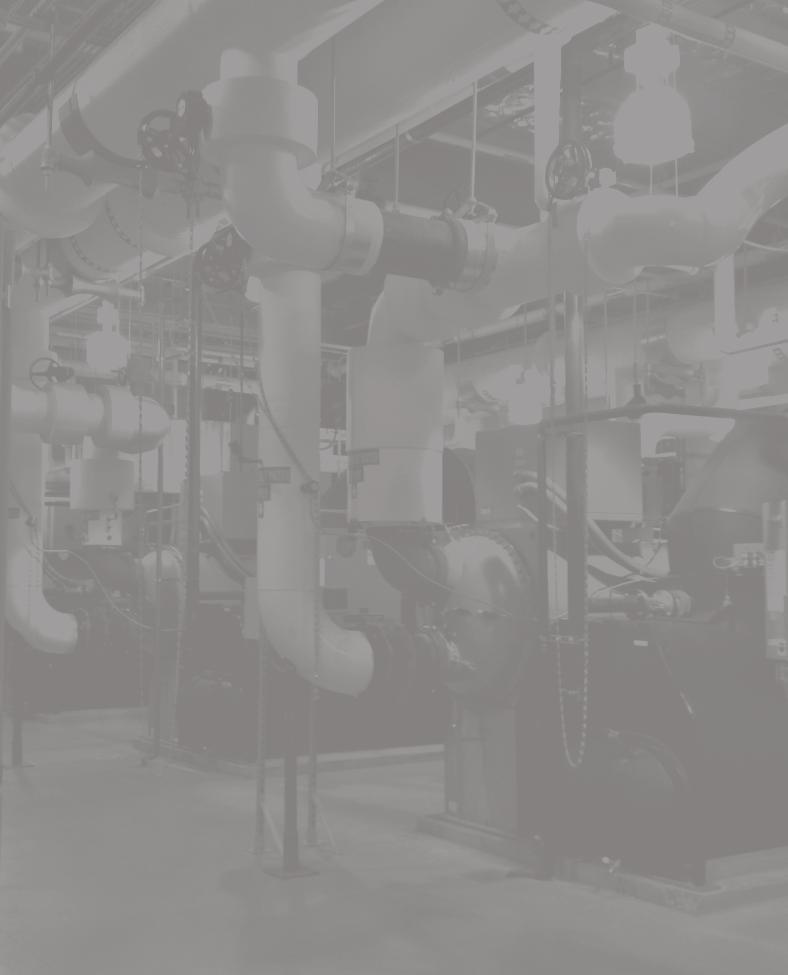
PROJECT PROFILE
REPLACEMENT OF HOT WATER SYSTEM AT STATE CORRECTIONAL INSTITUTION (SCI) - HOUTZDALE
Much of the construction put in place every year is not glamorous, or even visible. Billions of dollars are spent statewide in Pennsylvania annually to keep our water flowing or our power reliably on.
G.M. McCrossin Inc. is a multi-faceted general contractor that operates in that unseen market that maintains and modernizes our infrastructure. As the COVID-19 pandemic was easing, McCrossin completed a complicated $12 million replacement of hot and chilled water systems at SCI-Houtzdale.
SCI-Houtzdale is in Woodward Township, just south of the town of Houtzdale in Clearfield County. The facility houses roughly 2,000 and employs nearly 625 people. Built in 1995 and expanded in 2010, SCI-Houtzdale is comprised of 35 buildings on 65 acres within its secured perimeter. Its heating and cooling systems were underground and outdated by the late 2010s. The PA Department of General Services (DGS) issued a request for proposals from energy service companies in late 2017 to replace the hot and chilled water systems without doing a traditional design-bid-build procurement. DGS selected The Efficiency Network (TEN), a Duquesne Light Holdings company based in Pittsburgh, to deliver the project. TEN selected McCrossin as the general contractor and Entech Engineering as engineer of record. McCrossin worked with Snelick Construction Services from Greensburg, PA, as its minority business enterprise partner.
Projects like the energy upgrade at SCI-Houtzdale are delivered under the provisions of the Guaranteed Energy Savings Act (GESA). Procurement is done through a competitive sealed proposal method, which allows for projects to be accomplished without incurring major capital expenditures from the commonwealth. The successful energy service company assembles a design and construction team that delivers the project and pays for the project with energy savings over the life of the system.
“The GESA program has been successful in dealing with these kinds of projects. DGS does not have sufficient funding for all the needed capital projects,” says Bryan Haag, principal at Entech Engineering. “The commonwealth is near the lead in the nation in its focus on sustainability and energy efficiency. The GESA program has been a primary driver of that.”
“SCI-Houtzdale had coal fired boilers. The state of Pennsylvania used to have a requirement that all prisons were powered by coal, but now they have found that, because of the environmental issues, coal is no longer cost competitive to natural gas,” says Bob Leahey, president of G.M. McCrossin. “Houtzdale does not have natural gas, but we were able to get compressed natural gas. There are trailers that compress the natural gas and ship three trucks a day to the site to power the system. We eliminated
the coal boilers and installed natural gas boilers with a diesel boiler that they can use for several days in case of a problem.”
The scope of McCrossin’s work included the installation of two 350-horsepower, high performance dual fuel boilers, replacement of three 395-ton variable speed chillers and chilled water system, three cooling towers, and the replacement of 3.8 miles of distribution piping throughout the facility. The distribution system construction involved replacing the existing underground piping with an elevated system.
“We worked with The Efficiency Network to engineer the entire system. We started working with them during the proposal stage, when there were basically napkin sketches of the entire project,” Leahey recalls. “They had a rough idea of what kind of equipment they wanted and where they wanted the piping. From there we worked with them and the engineer, Entech, to design the entire system and do the installation for the entire prison.”
“Our focus was the central utility plant and the piping that feeds the prisons. Both those systems were well past their useful lives,” says Haag.
The engineering and design process took a couple of years to complete, following the formal agreement between DGS and TEN in November 2018. Construction began after the lockdown phase of the pandemic ended and was completed in 2022.
Because of the facility’s security requirements, all the work was done inside the perimeter fence. Leahey says that created several challenges.
“We were not allowed to have multiple trucks inside the fence. Only one truck is allowed at a time and the guards stayed with it continuously,” he says. “We had to stock materials at a central location inside the fence and distribute from there because we couldn’t go in and out of the gates. All the employees had to go through security on a daily basis. The productivity loss was around 30 percent.”
“Tool inventory was super critical. We created specialized trailers with shadow boards in them that showed where all the tools were that we were taking in. Those were inventoried daily, on the way in and out,” Leahey continues. “Even things like welding rods which can become weapons. We even had to account for the stub ends. This was not new for us. Since 2000, we have probably worked in a dozen prisons throughout the state correctional system.”
The security restrictions complicated the construction of a major piece of the project, the pipes that would carry utilities from outside the perimeter to the prison facilities inside.
“We put two 72-inch diameter pipes inside the perimeter walls. We bored underneath the fence and excavated a 20-footdeep pit that was 40 feet long and 12 feet wide,” Leahey says. “Obviously, we couldn’t have people walking through those trenches. We installed the pipe, welded it shut, and then excavated inside the prison so prisoners could not get out while it was exposed. We ran utilities through the casings and then tied in the whole prison. That took about three weeks.”
Tying in the heating and cooling was made more difficult by the condition of the existing systems. McCrossin was charged with cutting over the underground distribution to a new elevated system without outages. But the systems at SCI-Houtzdale were less than ideal.
“Keep in mind that the existing heating system was underground and very fragile. The goal was to get it above ground so that if there was a leak in the future, they could work on it immediately,” says Leahey. “When we started work, there were problems throughout the system. Working through all the problems, not only to meet the security requirements but to provide a continuous loop system throughout the prison, was challenging. It took the cooperation of all the parties involved to make it successful.”
“What made that project successful was we were able to make upgrades to the prison’s infrastructure and capitalize on the
Leahey credits the cooperation of all parties with the success of the project.
“The project was successful because we were involved at the beginning, working with Entech and Joe Richards at TEN to basically design-build the project. We had to work through a bunch of details that were very difficult, especially inside the prison,” Leahey says. “Even during the execution of the project, we would regularly encounter problems underground. You can imagine the underground of a prison with all the electrical, security, and technology. All those interferences required us to work together continuously to design the system and execute it. It was the cooperation of the team, and the Department of Corrections, that made it successful” BG
PROJECT TEAM
G.M. McCrossin, Inc.
General/Mechanical Contractor
The Efficiency Network Energy Service Company
PA Department of General Services
PA Department of Corrections
Entech Engineering, Inc.
McCrossin Foundations, LLC
Mustang Fabrication, Inc.
Owner
End User
Engineer of Record
Boring
Steel Fabrication

PROFESSIONAL. SKILLED. COMMITTED. PROUD.

These are the hallmarks the region’s union construction trades and contractors bring to the jobsite everyday. Our professional tradespeople and contractors bring the dreams and visions of our fast-growing region to life with a dedication that only those who live here, work here, and raise their families here can commit to. It is, after all, our home, our legacy.
We are also committed to providing opportunity for all who share these values and want to pursue a lifelong, lucrative and satisfying career. For more information on building with our union trades and contractors, or to explore career opportunities, please visit www.buildersguild.org where you will find direct links to our Trade Unions, Joint Apprenticeship Training Centers and Contractor Associations.



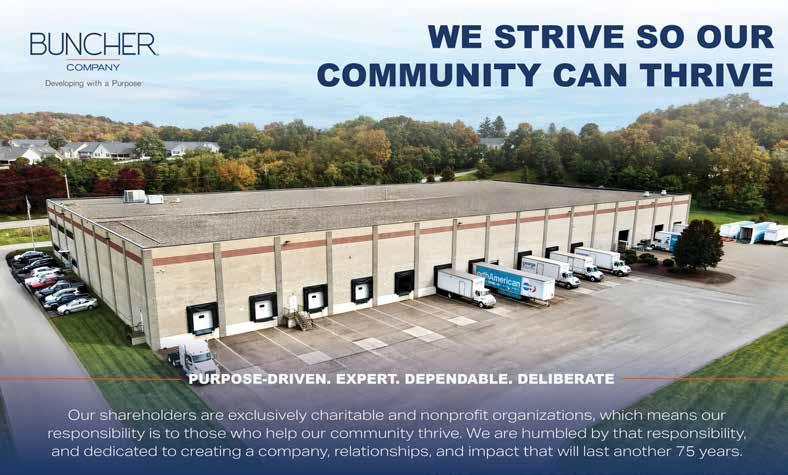

LEGAL PERSPECTIVE
MEDICAL MARIJUANA SAFETY EXCEPTIONS: WHAT CONSTRUCTION INDUSTRY EMPLOYERS NEED TO KNOW
BY DENISE ELLIOTT AND DAVID LEVINE
The Pennsylvania Medical Marijuana Act (MMA) was passed in 2016. At the time of passage, and still now, the number one question employers ask: what do we do with employees who use medical marijuana and who perform safety sensitive positions? Employers tend to be most concerned about employees who drive as an essential function of their job and those who operate heavy equipment and machinery.
While the MMA contains what has come to be known as “safety sensitive exceptions”; these exceptions do not provide employers with the answers or certainty they would like. Before we dive into the exceptions, here’s a brief recap of Pennsylvania’s current medical marijuana system.
First, the MMA uses the term “patient” to refer to anyone who has gone through the steps to become a certified medical marijuana user. This means the individual has done the following: (1) registered online and received a patient ID number; (2) attended an appointment with a certified physician who has confirmed that the patient suffers from one of the enumerated health conditions set forth in the statute (which include conditions like PTSD, chronic and intractable pain, seizure disorders, irritable bowel syndrome and anxiety) and that the patient will be under the continuing care of a medical professional; and (3) paid a fee to the state to obtain the PA Medical Marijuana Patient ID Card. Patients may select a physician with whom they have no prior relationship, and attend the visit via telehealth, to satisfy this portion of the process.
Second, once a patient is certified and has their ID card, they do not receive a prescription or a recommendation from their provider for the type of medical marijuana they should use to treat their condition. Rather, the patient takes their ID card to the dispensary of their choice, and it is the medical professional and other staff on site at the dispensary who helps the patient select their product.
Finally, while patients may obtain up to a 90-day supply, the cost of medical marijuana makes obtaining such amounts unlikely. Dispensaries offer frequent buyer programs, sales and discounts, making it more likely that patients will visit the dispensary more frequently to purchase smaller quantities of product.
Is an Employee “Under the Influence”?
When considering safety sensitive exceptions, Section 510(3) of the MMA states that “a patient may be prohibited by an employer from performing any task which the employer deems life-threatening, to either the employee or any employees of the employer, while under the influence of medical marijuana.” Further, Section 510(4) states that “a patient may be prohibited by an employer from performing any duty which could result in a public health or safety risk
while under the influence of medical marijuana.” Arguably, either of these sections could apply to employees who drive a vehicle or operate heavy equipment/machinery as part of their work duties. So, what is the problem? “Under the influence” is not defined! The Pennsylvania Superior Court has provided guidance; but it is still not definitive under the MMA.
In the summer of 2022, the Superior Court issued decisions in three criminal DUI cases — Commonwealth v. Dabney and Commonwealth v. Haney (published decisions) and Commonwealth v. Gordon (unpublished decision) — that specifically caught the attention of employers with
At the time of passage, and still now, the number one question employers ask: what do we do with employees who use medical marijuana and who perform safety sensitive positions?
employees who drive. The Superior Court addressed whether Pennsylvania’s zero-tolerance DUI law includes an exception for drivers legally using marijuana under the MMA. In each case, the driver was stopped and questioned, the police officer established probable cause to administer a drug test, the test was positive for THC and the driver was charged with DUI. The drivers argued that they were certified to use medical marijuana in accordance with the MMA and but for their legal medical use of marijuana, they would not have tested positive for THC.
In analyzing whether an exception should be made to Pennsylvania’s DUI laws, the courts noted language of the DUI statute which provides, “an individual may not drive, operate or be in actual physical control of the movement of a vehicle” when “there is in the individual’s blood any amount
of a … Schedule I controlled substance” or a “metabolite” of a Schedule I controlled substance (75 Pa. C.S. Section 3802(d)(1)(i), (iii)). The court noted that all marijuana, medical or otherwise, is a Schedule I controlled substance under the Controlled Substances Act and nothing in the MMA changed this classification.
Addressing the argument that the legalization of medical marijuana necessarily conflicts with the DUI statute, the Dabney decision disagreed. The court referenced the actions specifically permitted by the MMA — growth, processing, manufacture, acquisition, transportation, sale, dispensing, distribution, possession and consumption of medical marijuana. Notably absent from the list of permissible actions is driving. In the Gordon decision, while acknowledging that the decision “may lead to harsh consequences for patients with a valid medical marijuana prescription,” the Superior Court nonetheless upheld the DUI conviction noting that the DUI statute prohibits driving with marijuana metabolites in the blood, not the mere usage of medical marijuana. Finally, in Haney, the Court reiterated that “driving after using medical marijuana, a Schedule I controlled substance, is not included in the ‘lawful use of medical marijuana’ under the MMA.” Accordingly, a driver convicted of DUI is “not denied any privilege solely for ‘lawful use of medical marijuana.’”
Questions Remain Unanswered for Employers
Naturally, these court decisions caused concern among
employers and the question arose: if medical marijuana patients can be arrested for DUI simply for having trace amounts of marijuana in their system, how can companies ethically allow employees who use medical marijuana (and will therefore test positive) to operate vehicles? If allowed to drive, wouldn’t the company be knowingly allowing them to violate the law? Moreover, if they restrict medical marijuana users from driving vehicles, how can companies allow them to operate potentially more dangerous heavy equipment and machinery?
While these questions are logical and inherently reasonable, the answers weren’t exactly clear, because Dabney, Gordon and Haney did not address the employment relationship or the safety sensitive exceptions in the MMA. Rather, they were criminal cases; and a judge evaluating a claim for employment discrimination in violation of the MMA would not be bound by their holdings.
That left employers still uncertain as to obvious questions; Are we allowed to have an employee operate construction equipment, if we know that they are legally using medical marijuana? And equally important, are we required to allow them to operate equipment?
Common Pleas Court Applies the Superior Court Guidance to the MMA’s Safety Sensitive Exception
In January 2023, a Court of Common Pleas judge in Lancaster County extended the holdings of the DUI cases to dismiss a claim against an employer for employment discrimination in

violation of the MMA. In the case of Clark v. J.R.K. Enterprises, Clark, a traffic flagger, was terminated when he advised his employer that he could not pass a drug test due to his use of medical marijuana each evening. The employer designated the traffic flagger position as safety sensitive and terminated Clark’s employment in accordance with Section 510 of the MMA, arguing that Clark’s admission that he would test positive for THC was an admission that he would be under the influence. In his holding, Judge Jeffrey Wright cited the challenges of using testing to determine impairment from cannabis and reasoned that to “construe ‘under the influence’ to mean anything other than having any amount of marijuana in a safety sensitive patient-employee’s system would be altogether unreasonable.” Judge Wright relied on the decisions in Dabney, Gordon and Haney to support his holding. He noted “Dabney and Haney emphasize that for all the protections that the MMA provides to cardholders, the ‘lawful use’ of medical marijuana does not include driving after using medical marijuana. Lawful use of medical marijuana cannot, likewise, include dressing in safety gear, entering the roadway and directing drivers through precarious construction zones after using medical marijuana. Any other conclusion would be utterly irrational.” Further supporting his holding, Judge Wright noted that the MMA’s “catch-all” safety sensitive exceptions (Section 510(3) and (4)) do not include definitions of “under the influence.”
Accordingly, he reasoned that by making a clear decision to omit a specific definition of under the influence, the General

Assembly left employers to define the term. Without any scientific method to test or monitor for impairment, Judge Wright found that it is reasonable that employers would define “under the influence” as it is defined in the DUI statutes.
Six Considerations for Construction Industry Employers
So, what does all of this mean for employers who have employees in safety sensitive positions, specifically those who drive or operate construction equipment as part of their jobs? Simply, it means there is a compelling argument to be made that employees may be prohibited from doing so if they are using medical marijuana, and either actually test positive or will test positive on a drug test. The reasoning? Driving and operating heavy equipment are tasks that an employer could deem to be “life-threatening”; and “under the influence” can mean having any amount of marijuana in the employee’s system. Accordingly, under Section 510(3) of the MMA, the employer can arguably prohibit the employee from performing those jobs. While this argument is quite compelling in light of the DUI decisions and decision in Clark, a few notes of caution:
1. While an argument can be made, employers should be mindful that the law remains unsettled in this space. Dabney, Gordon and Haney are criminal cases; the Clark decision is a county level case; not a state appellate court case. The decisions are not binding on the Commonwealth Court, the Superior Court or a federal

MICA members are interior contractors who share a common mission: to provide their customers with the highest quality craftsmanship. We partner with the union trades that supply the best trained, safest and most productive craftsmen in the industry.
Alliance Drywall Interiors, Inc.
Easley & Rivers, Inc.
Giffin Interior & Fixture, Inc.
JLJI Enterprises
J. J. Morris & Sons, Inc.
T. D. Patrinos Painting & Contracting Company
Bank of America South Hills Village
Precision Builders Inc.
RAM Acoustical Corporation
Schlaegle Design Build Associates
TRE Construction
Wyatt Inc.
Interior contractor: RAM Acoustical Corporation
Another high quality MICA project
Photo by Candidly Yours Photography
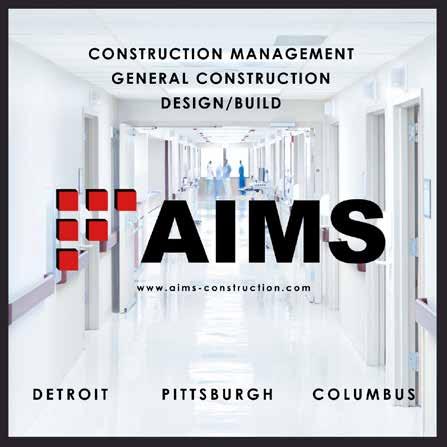

court addressing the impact of Section 510 on a claim for discrimination under the MMA.
2. The DUI cases turned on the language in the DUI statute, which references marijuana as a Schedule I drug. Notably, however, the federal government is actively engaged in the process of rescheduling marijuana to Schedule 3. Though this has not happened yet, it is anticipated that the rescheduling will happen by the end of 2024. What impact this will have on these holdings and the arguments available to employers based on those holdings is not yet known.
3. While the argument is strong — at least for now — for prohibiting an employee who utilizes medical marijuana from driving, due to the clear definition of “under the influence” in the DUI statutes, it is unclear whether other courts will be persuaded by Wright’s argument for an extension of the rationale to other safety sensitive positions like operating construction equipment or traffic protection.
4. Employees who utilize medical marijuana likely have a serious health condition that would qualify as a disability. Accordingly, employers must consider whether the employee can perform the essential functions of the job with or without reasonable accommodation. Ignoring the employee’s use of medical marijuana may not be a reasonable accommodation, but that does not mean other accommodations should not be considered. For example, is there another job to which the employee can transfer, or might a leave of absence be reasonable?
5. The language in Section 510 is that employers ‘may prohibit,’ not that they must prohibit. Moreover, because “under the influence” is not specifically defined, employers remain able to define it as something other than a positive drug test. Accordingly, if an employee is able to provide certification from their healthcare provider that off-duty use of medical marijuana will not cause them to be impaired or otherwise pose a risk to their safety or the safety of others while working, an employer may consider relying upon such certification and allowing the employee to consider performing their job. But an employer might also ask whether such reliance is in the best interest of the project, other employees or the public.
6. Finally, for any positions that require a commercial driver’s license (CDL) or are otherwise regulated by the U.S. Department of Transportation (DOT), there remains zero tolerance for use of marijuana, medicinal or otherwise, by such drivers. The DOT has published memoranda making it clear that it will not make exceptions to its drug testing policies for either medical or recreational marijuana. The MMA includes a provision that employers do not have to engage in activities that would violate federal law. Accordingly, employers may prohibit medical marijuana users from performing jobs that require a CDL.
Seek Legal Counsel
With so many questions related to medical marijuana and its impact on the workplace, employers must stay up to date on the latest developments. Companies should consult with their legal counsel to make decisions that minimize the risk of liability, protect the safety of employees and the public and are respectful of the rights and privileges of their employees. The legal landscape is frequently changing in this space, within states and from state to state. Employers should consider the following steps to ensure they stay compliant with the current laws:
• Review and revise drug testing policies
• Review and amend job descriptions to highlight essential functions that are safety sensitive
• Implement a robust reasonable suspicion drug testing program, which includes training of managers and supervisors on how to detect impairment, how to document suspicion of impairment and steps to take to send a potentially impaired employee for testing
• When in doubt, call your legal counsel BG
Denise Elliott is a labor and employment attorney at McNees Wallace & Nurick and a member of the PA Chamber’s Medical Marijuana Task Force where she is actively involved in discussions on medical marijuana in the workplace. Denise can be reached at delliott@mcneeslaw.com or 717-581-3713. David Levine is a construction law attorney in McNees Wallace & Nurick’s Pittsburgh office. David can be reached at dlevine@mcneeslaw. com or 412-227-2501.




Frick Environmental Center LEED Platinum

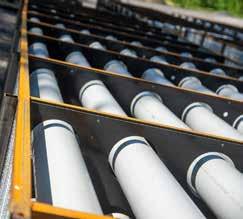

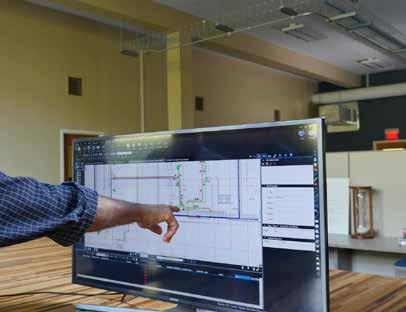



FIN ANCI AL PERSPECTIVE
SEC PUBLISHES FINAL CLIMATE RISK DISCLOSURE RULES
BY KRIS MACOSKEY
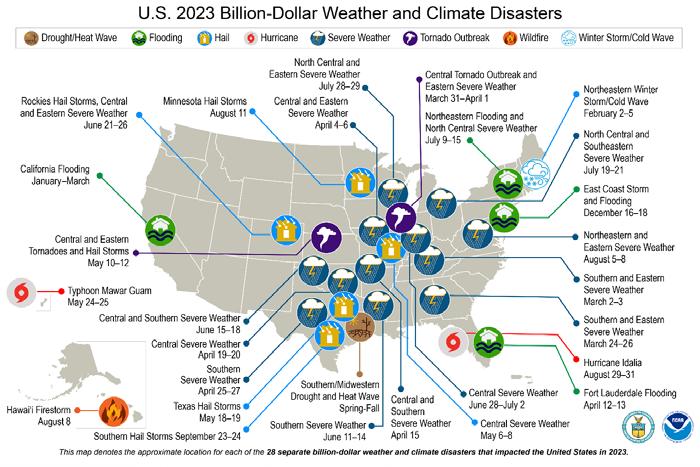
Last year was historic for billion-dollar climate disasters in the U.S. Twenty-eight separate events struck as shown in this figure from the National Oceanic and Atmospheric Administration (NOAA)[1]:
That is about 20 more annual events than the long-term average. As shown on page 45, each of the past four years has exceeded the long-term average of extreme events.
On March 28, 2024, the U.S. Securities and Exchange Commission (SEC) introduced new rules aimed at helping investors understand the climate risks companies face. As they say in the preamble to the final rule:
Climate-related risks, their impacts, and a public company’s response to those risks can significantly affect the company’s financial performance and position . . . Many investors . . . currently seek information to assess how climate-related risks affect a registrant’s business and financial condition . . . Investors also seek climate-related information to assess a registrant’s management and board oversight of
climate-related risks so as to inform their investment and voting decisions.[2]
The “Enhancement and Standardization of Climate-Related Disclosures for Investors”[3] effective date is May 28, 2024[4]. The due dates for disclosure vary depending on the filing status of SEC registrants as shown in the table below. The SEC estimates that some 2,700 U.S. companies and hundreds of foreign companies filing with the SEC will be affected by the rules to be codified in 17 CFR §§ 210, 229, 230, 232, 239, and 249.
1. greater than $700 million public float (generally the value of outstanding stock held by public investors)
2. Between $75 and $700 million of public float but not smaller reporting companies and emerging growth companies
3. Non-accelerated filers are generally those with public float less than $75 million









Designed and Built to Get Results
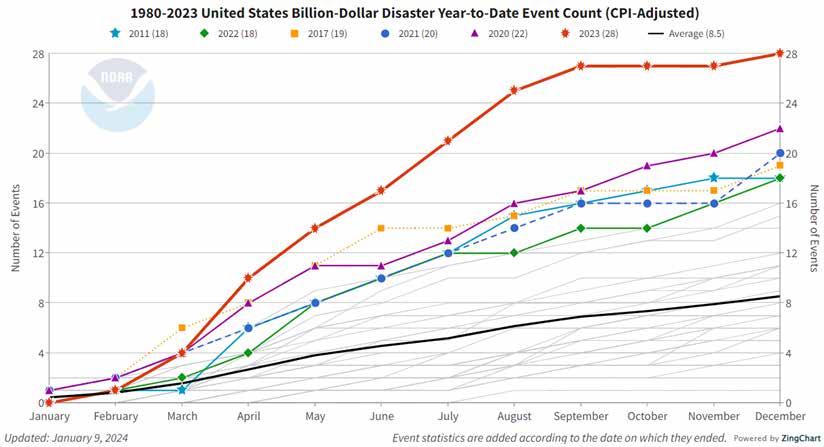

SEC’s final rule is significantly different from what was proposed in March 2022 due to the 24,000-plus comments received: the most for any SEC rule-making in its 90-year history.[6] A point-by-point discussion of those changes can be found in the 240-page preamble to the final rule but possibly the most significant change for most reporters, as indicated in Table 1 Item 3, is that Scope 3 greenhouse gas (GHG) emissions disclosure is not required. One thing that has not changed is the four-part structure of required disclosures that is derived from the Task Force on Climate-Related Financial Disclosure (TCFD).[7] Those four parts and their corresponding rule sections are governance (§229.1501), strategy (§229.1502), risk management (§229.1503), and targets and goals (§229.1504). Those four parts have been used by TCFD since 2017 to represent the core elements of how organizations manage risk.[8] As illustrated in Figure 3, the TCFD structure consists of:
• Governance – the leadership and decision-making structure
• Strategy – wherein an organization identifies risks and their associated impacts
• Risk Management – where processes aimed at assessing and managing risks are identified and managed
• Targets & Goals – where organizations gather data to assess performance
With that as context, let’s take a look at key requirements within each of these four areas.
Governance
(§229.1501)
The SEC’s stated intent in this section is to “enhance investors’ ability to evaluate a registrant’s overall management of climaterelated risks by improving their understanding of the board’s role in overseeing those risks.”[9] The rulemaking does not oblige organizations to “shift governance behaviors” only to disclose how they oversee climate-related risks. No disclosure is required if there is no relevant information. But if applicable, disclosure requirements include any committee(s) responsible
Table 1: SEC Climate Disclosure Rule Applicability and Compliance Dates by Fiscal Year
NOAA Summary of U.S. Billion-Dollar Disaster Trend
Caliber Contracting Services
•Allegheny College Bentley Hall Gen. Contractor Massaro Corp.
•Gateway Middle School Gen. Contractor Liokareas Construction
•Boardwalk II Gen. Contractor Burns Scalo Development, Inc.
•Western PA Surgical Center Gen. Contractor P.J. Dick
•
•




For over 100 years Local 66, in partnership with our employers, has been committed to providing qualified and competent Operating Engineers. For Local 66, meeting your short and long term employment needs is a priority.
The Operating Engineers lead the nation in pipeline training.
The best trained, most capable work force. Professional tradesman and tradeswomen have received the specialty training needed to meet the complex challenges of your project.
Services you can count on. We’ll work with you to answer any questions or solve any problems at your convenience.
Smart business know-how. You’ll benefit from our years of experience and a proven track record we bring to the job.
Bottom-line dollar-for-dollar value. Value is bringing the highest professional and performance standards to your job site – from the beginning of a project to its completion. We at Local 66 are committed to being the premier value provider of Operating Engineers in the region.



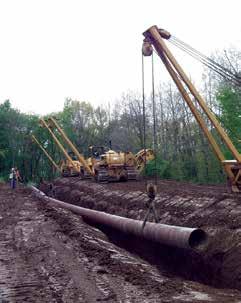


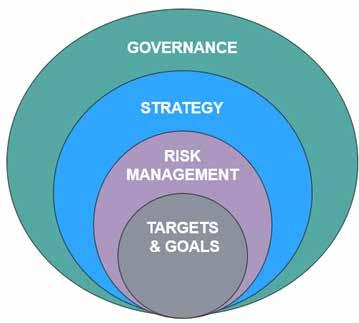
for climate-related risk oversight; processes used to inform the board of risks; if targets or goals are set, how progress toward them is overseen; and how management assesses and manages material climate-related risks. Governance topics must be disclosed per the schedule for Item 1 in Table 1.
Strategy (§229.1502)
Climate-related risks are defined in the rule as “the actual or potential negative impacts of climate-related conditions and events on a registrant’s business, results of operations, or financial condition.”[10] Consistent with TCFD precedent, the SEC categorized climaterelated risks as either physical or transition. Physical risks may impact a business acutely such as short-duration wildfires, flooding, and severe storms, or chronically such as long-term changes in sea level, rising air temperatures, or increased drought. Transition risks are associated with the societal transition to a low-carbon economy and include topics such as changes in law or policy, changes in market demand for carbon-intensive products, devaluation of carbon-intense processes or products, and reputational risks associated with the inability to achieve stated climate-related goals.
applicable, that companies have an extra year to address (see Table 1, Item 2):
• §1502(d)(2): quantitative and qualitative descriptions of material expenditures to mitigate or adapt to climate-related risks
• §1502(e)(2): quantitative and qualitative descriptions of material expenditures and material impacts on financial estimates as a direct result of any transition plan (meaning any plans that have been developed to manage material transition risks)
Risk Management (§229.1503)
The risk management aspects of disclosure address how an organization identifies, assesses, and manages material climate-related risks. These elements also fall under the timing for Item 1 in Table 1. Information to be provided, as applicable, includes:
• how the organization identifies if they have or could incur a material risk
• how they decide whether or not to mitigate or adapt to any risks
• how those risks are prioritized
• if risks are being managed, then how climate-risk management processes have been integrated into the overall organizational risk management system
Climate-related risks are defined in the rule as “the actual or potential negative impacts of climaterelated conditions and events on a registrant’s business, results of operations, or financial condition.”
Targets and Goals (§229.1504), Metrics (§229.1505), and Assurance (§229.1506)
To the extent an organization has identified material impacts from such risks, disclosure of them relative to both the shortterm (next 12 months) and long-term (greater than the next 12 months) is required. Also required as strategic disclosures are discussions of scenario analysis methodologies and internal carbon prices, if applicable. These strategy elements would be disclosed following the timeframes for Item 1 in Table 1 except for these two expenditure-related topics, if
Organizations must disclose the extent to which GHG reduction targets (e.g., net-zero by 2050) or specific goals (e.g., 30 percent reduction from baseline by 2030) have materially affected their company. Elements of the disclosure will include the scope of the emissions (i.e., 1, 2, or 3), units of measurement (typically CO2e), the specific time horizon, the baseline year, and a discussion of how they intend to meet the goal. Progress made toward achieving any goal is also required. Also, if carbon offsets or renewable energy
Figure 3: The TCFD Four Pillars of Climate Risk Disclosure
credits are material to achieving targets or goals, specific disclosures are required about them. All these elements fall under the timing for Item 1 in Table 1 with the exception of an additional requirement. That is if the organization has had material expenditures or impacts as a direct result of a target, goal, or actions taken to meet them, then a quantitative and qualitative description of those expenditures and impacts on financial estimates is required according to the timing for Item 2.

Join MCAWP as we support the Children’s Home

All proceeds from the MCAWP Golf Outing will be donated to The Children’s Home, part of the Lemieux Family Center.
The Children’s Home has many different programs for children and families in need at no cost to the families. With the help of MCAWP and many other entities, the Children’s Home can continue to service our community!
Relative to GHG emissions, the rule states that a registrant “must disclose its Scope 1 emissions and/or Scope 2 emissions, if such emissions are material.” This is in contrast to existing Environmental Protection Agency reporting requirements at 40 CFR 98 that require certain categories of sources that emit more than a specific threshold of GHG to report annually. It is also different in scope than the voluntary disclosures that many corporations have provided in annual sustainability reports. Such voluntary disclosures prompted the SEC to send letters to corporations inquiring as to the materiality of those disclosures. Now, the burden will be on organizations to assess for themselves whether their GHG emissions are material or not. While the rule does not require the reporting of Scope 3 emissions, if corporations have established material targets or goals and they have included Scope 3 emissions in their accounting of progress toward those goals, then they would be required to disclose similar information as for the Scope 1 and 2 emissions. As shown in Table 1, material GHG emission disclosures will be required for large corporations with the fiscal year 2026 filings.
Individual Golfer - $125
Foursome - $500
Sponsorship opportunities are still available!

Elevate ~ Educate ~ Advocate
The final element addressed here concerns requirements to demonstrate that any GHG emission figures being disclosed can be relied on. Two forms of attestation are specified: limited assurance (essentially a technical review) and reasonable assurance (a more formal audit). These provisions do not take effect until several years after the initial disclosures as shown in Table 1, Items 4 and 5. Requirements for who can provide assurance and how it is to be documented are stated in the final rule.
Conclusion
Despite the April 4 implementation stay and the legal proceedings that will determine the final form of this rulemaking, the characterization of GHG emissions and the assessment of climate-related risks have already become common for major corporations. The SEC cites research performed on 52,778 annual reports from 2016 through 2022 that illustrates the presence of climate-related keywords in filings has increased from about 12 percent to about 40 percent over that time.[11] Another figure illustrates by industry sector the percentage of filings that contain climate-related keywords.[12] It shows that 85 percent or more of businesses
in the electric services, maritime transportation, steel manufacturing, and paper & forest products industries are already mentioning climate-related topics. The same figure points out that in many other sectors including chemicals, textiles, mining, and automotive, there tend to be far fewer filings that mention climate-related topics. Whether these differences are because climate risk has been determined to be less material to some sectors or governing bodies in some sectors have been more focused on these matters than others may become apparent as SEC filers are required to take a consistent look at climate risk disclosure. When combined with the emerging domestic climate rules such as those in California and existing related disclosure requirements in the EU, we will likely all be hearing more about corporate carbon footprints and how they are managing their exposure to the next climate catastrophes.
[1] 2023: A historic year of U.S. billion-dollar weather and climate disasters | NOAA Climate.gov
[2] 89 FR 21669
[3] 89 FR 21668
[4] Due to numerous legal challenges, on April 4 the SEC voluntarily paused rule implementation which means that the actual effective date will most likely be delayed.
[5] Materiality, as used here, refers to the SEC definition at 17 CFR 230.405: “The term material, when used to qualify a requirement for the furnishing of information as to any subject, limits the information required to those matters to which there is a substantial likelihood that a reasonable investor would attach importance in determining whether to purchase the security registered.”
[6] https://www.sec.gov/news/pressrelease/2024-31 and https://news.ufl. edu/2024/03/sec-climate-disclosurerules/#:~:text=After%20announcing%20 its%20initial%20proposal,received%20 for%20an%20SEC%20rule
[7] 89 FR 21673
[8] TCFD, Recommendations of the Task Force on Climate-Related Financial Disclosures, June 2017, available at https://assets. bbhub.io/company/sites/60/2021/10/ FINAL-2017-TCFD-Report.pdf
[9] 89 FR 21712
[10] 89 FR 21914
[11] See Figure 1, 89 FR 21836
[12] See Figure 2, 89 FR 21838
This article first appeared as a blog post on the Civil & Environmental Consultants’ (CEC) website, https://www. cecinc.com/blog/2024/04/10/sec-publishes-final-climaterisk-disclosure-rule/. Kris Macoskey is air quality vice president at CEC. He can be reached at kmacoskey@cecinc. com or 412-249-3147
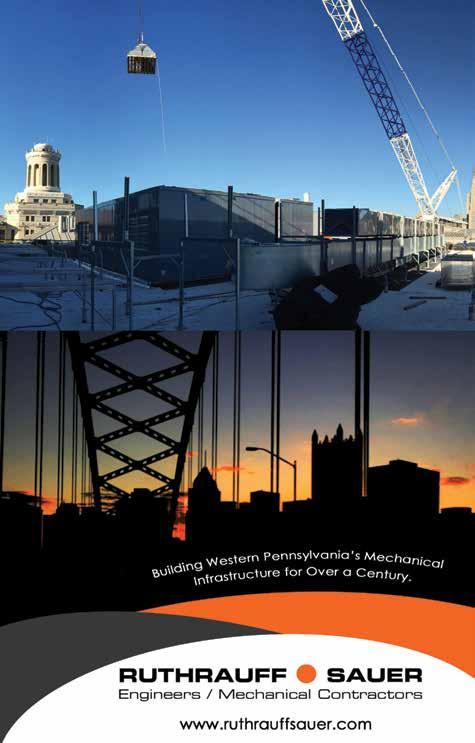



TREND TO WATCH
CATALYSTS OF CHANGE: EXPLORING MEGA TRENDS RE-SHAPING THE ENGINEERING AND CONSTRUCTION INDUSTRY (PART 2)
BY JAY BOWMAN
“Time makes more converts than reason.” – Thomas Paine
In his 1776 book Common Sense, Thomas Paine tried to spark the American Revolution by challenging colonists’ long-held custom of accepting British rule.
His insight raises questions that are relevant today: What habits are unconsciously engrained in our behaviors? What do we take for granted about the way the world works? And what changes will the future bring that today we might reject as unreasonable?
Most engineering and construction (E&C) firms are planning one to five years in advance using mental models from the present. Yet imagining what is likely to occur down the road and planning accordingly can be helpful. Understanding industry trends and drivers is key in this process.
Megatrends are powerful, multidimensional social shifts. They can be economic, political, cultural, or technological. Like tectonic plates, they shift the world, and often we see their manifestations without contemplating their magnitudes. Consider, for instance, how the widespread use of cell phones is a symptom of the broader digitalization of work and communication.
Although megatrends often meet resistance (think of Luddites rejecting the Industrial Revolution), they move forward inevitably. Before long, megatrends are the new normal.
In the May/June BreakingGround, we explored four technologybased megatrends reshaping the built environment:
• The ongoing transition to e-commerce and continued digitalization of society.
• The growth of artificial intelligence.
• The permanent arrival of remote and flexible work.
• The rise of data and cybersecurity issues.
In part two we explain the megatrends of continued urbanization, rising income inequality, increased political polarization and further globalization. We invite E&C leaders to reflect on how these megatrends will affect labor markets, competition, supply chain and materials sourcing, and their current technology stack. At every interval it pays to ask, “If this mega trend were to grow exponentially, how would we adapt?”
Continued Urbanization
Urbanization describes the trend of an increasing number of people moving away from rural areas to more densely developed urban or suburban developments. The U.S. has been slowly urbanizing for the past several centuries, but this trend has accelerated dramatically in recent decades and will continue.
Although urbanization can describe the creation of concentrated, connected metro areas, it is just as much about sprawl. Loosely defined, sprawl refers to less dense and less connected suburbs and exurbs with a lack of architectural diversity and long driving distances to amenities.
In 2023 more than 360 incorporated places in the U.S. had populations of more than 100,000, up from just 200 several decades earlier. The fastest-growing cities are in the South and the West. Land devoted to urban uses is projected to more than double to 8.1 percent in 2050 from 3.1 percent of the U.S. in 2000.
Urbanization will drive heavy civil investment as populations grow and strain roads, bridges, and other infrastructure. The U.S. water infrastructure is particularly in need of renewal and repair, due to its age and shifts in rainwater patterns.
At the same time, urbanization exacts a heavy toll on the environment. The expansion of cities brings deforestation, habitat loss and increased energy consumption. E&C firms will be challenged to minimize the environmental impacts of growth and to account for carbon costs of construction.
As populations expand, the advantages of modular construction, such as increased speed, reduced waste, and lower costs, are increasingly evident. Further, design-build has expanded significantly as urban megaprojects take hold. Finally, urbanization — along with geographic income inequality, discussed below — concentrates opportunity. Now 50 percent of construction activity takes place in just 22 markets. This means greater competition for bids and workers.
Income Inequality
By multiple measures, the U.S. is increasingly a place of unequal income, wealth, and opportunity. Income inequality has been growing in the U.S. for at least 50 years, with upper-income households enjoying more income growth than lower-income households.
If you earned $14,530 a year in 1977, you would be in the lowest 10 percent of the nation’s households, whereas households in the 90th percentile of income distribution earned $127,000 a year or more, according to the U.S. Census Bureau. In 2022 the 10th percentile limit was $17,100, and the 90th percentile limit on the income distribution scale was $295,000.
Put another way, people in the lowest 10 percent of income in the U.S. saw their annual incomes grow 18 percent over five decades. People in the top 10 percent saw their incomes grow 132 percent over that same period.
The rise in income inequality is tied to several factors, including, in no particular order, technological change,

globalization and the eroding value of the minimum wage. It’s also tied to geography.
There are wide differences in the median income based on where a person lives. According to the U.S. Department of Commerce, geographic income inequality has risen more than 40 percent between 1980 and 2021, again measured by the difference between the per capita income in places like New York City ($69,000 on average in 2021) and rural small towns ($32,000 on average, 2021). Fifty years ago, these differences existed, but the spread was smaller.
For the E&C industry, geographic income inequality could lead to underinvestment in more rural parts of the country or communities where salaries are not rising as quickly. At the same time, we can expect heightened demand for affordable housing; by some estimates, the U.S. needs 4 million to 5 million more homes on the market than it has right now.
The push to build affordable housing will be hurt by neighborhood pushback, onerous regulations, and costly construction methods.
However, the future bodes well for companies that can take costs out of multifamily projects through better design and modular construction. E&C companies that want to build affordable housing may also need to forge multistakeholder partnerships, win government subsidies and conduct significant public outreach to win over neighbors.
Intensifying Political Polarization
Ten years ago, it would have been unthinkable for a conservative governor in a pro-business state to risk shutting down a $1 billion real estate development. Yet that’s what happened last May. Due to a feud with the Florida governor, Disney nixed a planned office complex
development in Orlando that would have brought in some 2,000 highly paid jobs.
This is an example of the megatrend of political polarization. Polarization is real and has been growing. A Pew Research Center analysis finds that, on average, Democrats and Republicans are further apart today than at any other time in the past 50 years. Both parties have moved away from the ideological center, and individuals are geographically segregating themselves by moving to like-minded communities.
For E&C companies, political polarization simply brings more uncertainty to projects. For example:
• Different communities governed by different ideologies may prioritize varying building codes or regulations, potentially leading to additional compliance requirements.
• The ability to forge long-term agreements in publicprivate partnerships could be affected by polarizing political viewpoints.
• Large federal infrastructure bills and initiatives could stall due to disagreements or threats of government shutdown.
Overall, E&C firms should expect increased risk and greater pushback around projects and plan on more time to engage with affected communities and stakeholders.
Globalization
The world’s economies have become increasingly entwined, and while we’ve seen a recent move toward deglobalization, this is an example of short-term resistance to an inexorable trend.
In 2008 world trade as a share of overall economic activity
Illustration by Christopher Burgstedt
peaked at 61 percent. It has since receded to 57 percent, still far above rates of trade in earlier decades. In some cases, global trade is being rerouted from China to less politically risky countries such as Vietnam and Mexico.
“The efficiencies lost mean higher costs for households and businesses, and profit margin pressure for companies,” wrote Jon Hilsenrath and Anthony DeBarros in The Wall Street Journal. “In boardrooms, it means more attention needs to be paid to risk and a widening landscape of potential crises.”
In short, while globalization is here to stay, it introduces the possibility that supply chains will become increasingly fragile and suffer disruptions. E&C companies will need to create contingency plans.
Changes to global trade also mean increased demand for transportation and warehouse construction. Warehouse and distribution, a subset of commercial, has grown in recent years to represent more than 50 percent of the commercial segment. Transportation construction is projected to reach a compound annual growth rate of 8 percent in the next five years.
At the same time, globalization introduces new competitors. According to the Engineering News-Record, in 2023 two of the top 20 international engineering and construction firms ranked according to construction revenue generated outside of each company’s home country were U.S.based Fluor and Bechtel. By contrast, eight megafirms are in China. Could international firms dominate our U.S. economy and introduce powerful foreign competitors for U.S. construction contracts?
Questions to Ask Now
“Change is the law of life,” said John F. Kennedy, “and those who look only to the past or present are sure to miss the future.”
In our series on megatrends, we’ve presented developments — some familiar, some surprising — that are likely to grow over the next three decades. But how hard and frequently are we thinking about disruption?
The best way to prepare is to consider how megatrends affect all aspects of building:
• Who is doing the building?
• What is being built?
• Where is it being built?
• How is it being built?
FMI’s strategy practice leaders urge you to hold your business up to that future vision and ask: If things were to change significantly in any of these four areas, how well could we adjust? BG
This is the second of a two-part series on mega trends authored by Jay Bowman. The first appeared in the May/ June BreakingGround. Bowman is a partner at FMI. He can be reached at jay.bowman@fmicorp.com.



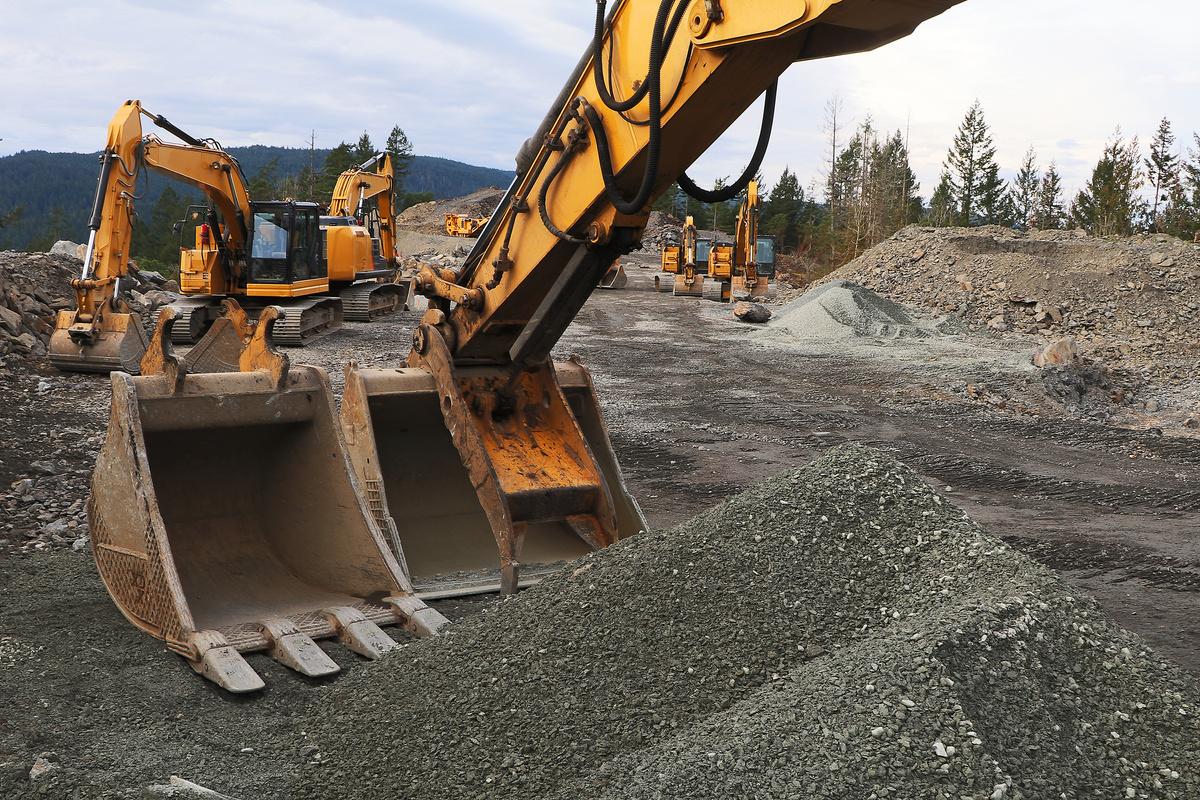

BEST PRACTICE
USING WASTE SEGREGATION FOR GREENER DEMOLITION
Volpatt Construction completed the restoration of the Carnegie Music Hall earlier this year, a project that it is justifiably proud of for the high level of detail in fit and finish. For all its detailed restoration, the project is also a model for a grubbier aspect of construction: demolition.
Michael Volpatt, vice president of Volpatt Construction, is an entrepreneur with a background in communications, technology, and writing (including a cookbook). When he returned to Pittsburgh to join the family business five years ago, he brought that different perspective to construction. It was a perspective that matched up well to his brother Ray’s desire to approach construction differently. Recycling and diverting construction waste was one of the initiatives Michael sought to pursue.
“The Carnegie Music Hall project was the first I was involved in where we were intentional about diverting the demolition materials from the landfill,” Michael Volpatt says. “We have been working at the Carnegie Museum for years. Typically, you build an exhibit, and it stays up for three months. When it is over, we demolish it, and it goes in the dumpster.”
“I wanted to start collecting all our data around waste disposal and diversion. We did The Forum Gallery at the Carnegie Museum of Art and diverted the majority of the waste. Then we had 3,600 pounds of church pews taken from the Abiding Missions project. Since we started collecting the data we have diverted 12,000 pounds of waste from landfills on six projects.”
Volpatt Construction has worked with Construction Junction and door recycler, Doors Unhinged, and found a very active recycling partner in Michael Brothers Hauling. Will Hancock, business development manager for Michael Brothers, has an extensive resume building construction demolition recycling facilities in Pittsburgh and the Denver area. Michael Brothers recycles much of the construction waste it collects and offers source separation services at the job site.
“Across the state United States, the average construction waste recycled is 70 percent. I am the chair of the End Markets Committee for the Construction Demolition Recycling Association, which includes most of the demolition recyclers in the United States,” Hancock says. “Depending on when in the scope of the job you get involved that could range from 20 percent to 100 percent. Seventy percent of the waste stream that comes into construction demolition facilities is wood. But we’ve got cardboard, metals, aggregates, rigid plastics, film plastic, electrical wires, copper, brass, aluminum, and other materials. In a perfect world 100 percent of everything that comes off a job site is recyclable if you have a home for it.”
“When my brother got here, we started looking at jobs that had LEED requirements and he saw that part of the LEED requirements was diverting waste. He saw that we obviously were not doing a good job of diverting waste and started asking what we could do better,” Ray says.
Volpatt says that he was interested in using the next exhibit project at the Carnegie – at the Heinz Architectural Center – to take waste diversion to the next level.
“There were beautiful pieces of furniture that were part of the display and beautiful artwork associated with them. We priced the demolition, and I asked if they were keeping or disposing of the furnishings. They were going to dispose of them. I sent photos of the furniture to Paul Zellers at Construction Junction, and he wanted all of it,” Michael recalls. The total waste on that project was 2,991 pounds. We diverted 2,849 pounds. That’s 95 percent.
Hancock notes that in Pittsburgh, it has been more challenging finding a home for the wood waste. Michael Brothers will grind wood that it cannot find a reuse for to create mulch, but the recycler has also begun a business relationship with a Colorado-based company called Biochar Now, which uses a slow-pyrolysis kiln process to convert waste wood into biochar.
“We’re going to take the wood and convert it into biochar. Biochar is a new material, but it has a lot of commercial applications. It is being used in manufacturing lithium batteries. It is used for water filtration. The marijuana industry uses biochar for soil enhancement, and it’s used in agricultural because it adds necessary nutrients back into the soil for farmers that do not rotate crops,” Hancock explains. “It has huge environmental benefits.”
For Ray Volpatt, the leadership in waste diversion is another way to differentiate Volpatt Construction in a market that has no shortage of competitors. But, similar to his investments in construction technology companies ShareIntech and Ursa
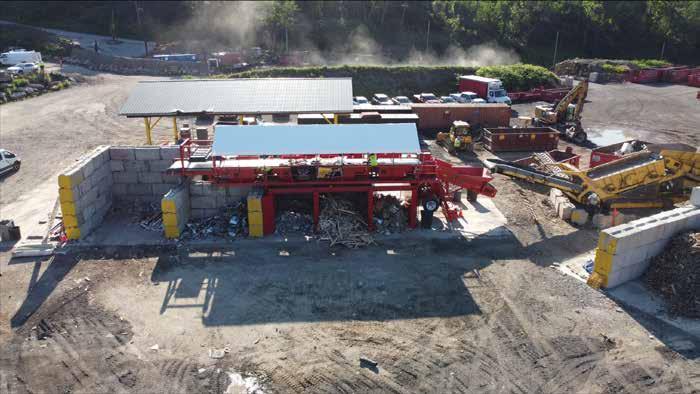
Leo, Ray is also trying to move Volpatt Construction to find more efficient ways to build more efficient buildings.
“When my brother got here, we started looking at jobs that had LEED requirements and he saw that part of the LEED requirements was diverting waste. He saw that we obviously were not doing a good job of diverting waste and started asking what we could do better,” Ray says. “It has been a journey from the Ursa Leo days to now, but it is just another means of being more friendly to the environment in an industry that is not friendly to the environment.”
Beyond the benefits to the environment and the business differentiation, there is a business case for waste diversion and recycling, both for the contractor and the recycler.
“There is a benefit if you’re working in a space that doesn’t allow you to drop a dumpster. The answer to the question of whether it costs us more or less is not known yet,” Ray says. “In some cases, it would take more time and cost more to deconstruct than to simply demolish. The savings is you don’t put it in a dumpster. You save time by leaving it on the dock for a salvage company to take it away. There are also savings to the owner if you’re astute enough to have the salvage company come to the site prior to creating a demolition package.”
“We’re spending a fortune each month at the landfills and there are viable commodities that are coming into our facilities that we can divert from the landfill. All may not have a profit but if we are not spending to dump in the landfill we are saving,” says Hancock.
“We are creating products with the materials that come in. We crush aggregate and reuse it or sell it. I can bail plastics and sell it to a manufacturer. We can take metals to the mill directly or sell to brokers. We bail and sell the cardboard to a paper factory. If it comes across our sort line, we’ll have a market for it,” he continues. “For Volpatt we’re doing source separation on the job site in our Tommy cart, but for all the dumpsters that come to our facility we tip on the floor and sort. Not only are we getting a tip fee at the front end, but we’re getting paid for the material when we divert it and create a product out of it.”
For Michael Volpatt, considerations about waste diversion are now part of the sales and preconstruction process, even in a hard-bid situation. At Volpatt Construction’s Newell Simon Hall job site at Carnegie Mellon University, Michael toured the area to be demolished with the owner and the salvage company. All the items and materials to be salvaged were catalogued and tagged before Volpatt Construction took ownership of the site. Michael sees this process becoming universal, especially with repeat institutional owners.
“We had a meeting with a client to talk through our relationship and part of it involved waste management and waste reduction. The client told us that no other contractor was having that conversation with him,” he says. “I think it’s a source of differentiation right now, but it will become a requirement and it will become a baseline competitive standard. I would hope so, because waste diversion is so important.” BG
Michael Brothers uses a Keystrack Mobile Screen to segregate materials over four inches at its facility. Photo by Boyd Jones.

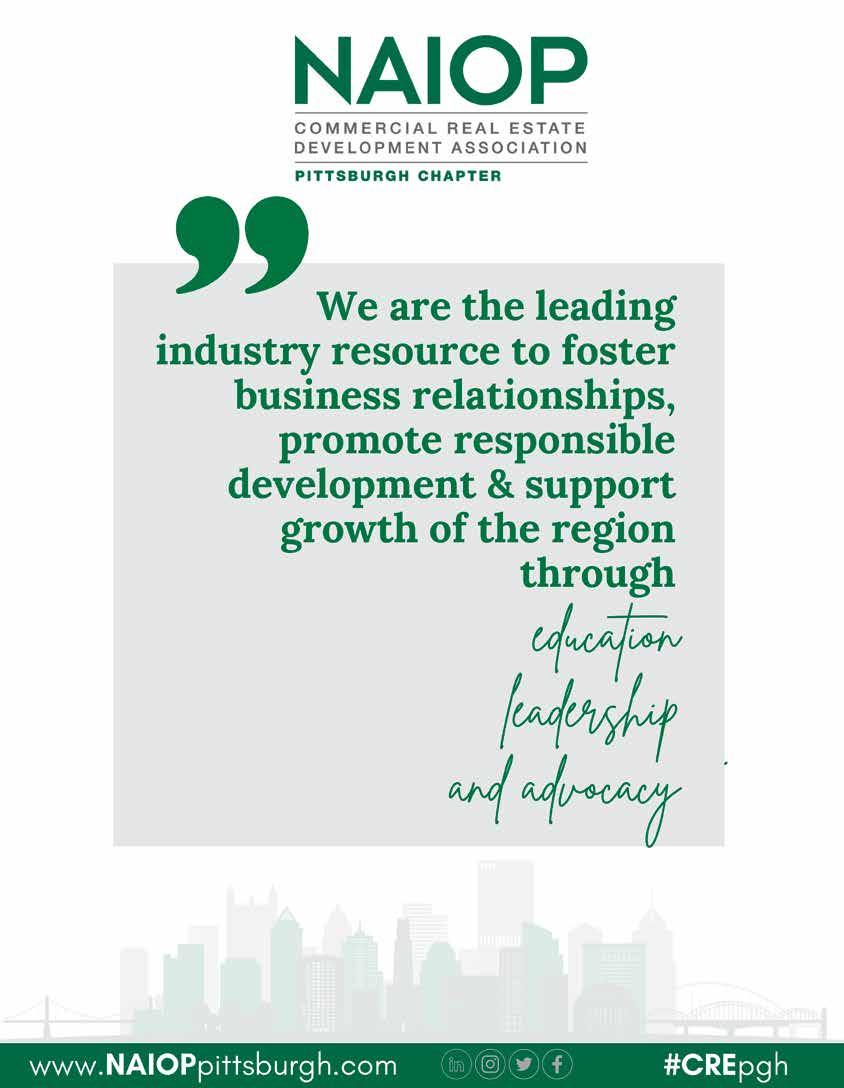
INDUSTRY & COMMUNITY NEWS




(From left) PJ Dick’ Dom Matarazzo, Brooke Waterkotte from Easley and Rivers, Coby Green from PJ Dick, and Tim Mackin from the MBA.
(From left) Zak Roberts and Jake Roberts from A. Martini & Co., Evan Yohe from Easley and Rivers, A. Martini’s Mike Yohe at the MBA Young Constructors’ golf outing at Olde Stonewall on May 13.
(From left) McKamish’s Naley McKamish, TEDCO’s Kyra Sarver, Dara Collins from PJ Dick, and Jamison Vernallis from Landau Building Co.
(From left) Tim Chesleigh, Joel Niecgorski, Erick Dixon, and Ken Umbel from the Eastern Atlantic States Regional Council of Carpenters.
Lori Wisniewski Azzara lazzara@cohenseglias.com
Lisa M. Wampler lwampler@cohenseglias.com







(From left) Bernie Kobosky from PJ Dick, Pitt’s Ron Liebow, and Ralph Horgan from CMU at NAIOP Pittsburgh’s 31st Annual Awards Banquet on May 9.
(From left) Westinghouse’s Jamie McMaster, Mike Abriola and Sean Myers from Turner Construction, and Westinghouse’s Eric Laurent.
(From left) Rycon’s Brad Carse, Mike Klena, and Phil Marraway, and Aaron Reed from Reed Building Supply.





(From left) Warren Bulseco from WTW Architects an AE Works company, Chris DiLorenzo from Turner Construction, Danielle Maritzer from Pieper O’Brien Herr Architects, and Turner’s Megan Corrie at the May 20 CREW Pittsburgh Golf Outing.
(From left) Howard Solomon from the Masonry Contractors Association of Western PA, Trudy Van Kirk from Dagostino Electronic Services, and Lindsay Campbell from Intertek Security.
Sean Foley (left) and Rich Campbell from the Eastern Atlantic States Regional Council of Carpenters.
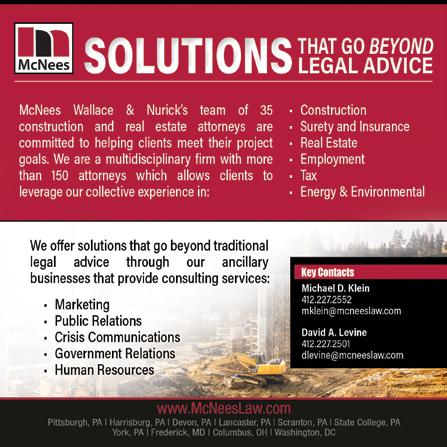






(From left) Naley McKamish and Marc Mushnok from McKamish, Adam Cummins and Susie Slater from PJ Dick.
(From left) the MBA’s Elli Fry, Erica Brusselars from Willis Towers Watson, Annalise Mursch from Sargent Electric, and TEDCO’s Kyra Sarver at the June 3 MBA Young Constructors/NAWIC Pittsburgh Chapter clay shoot.
(From left) Marsa’s Drew Erny and Dave Neuhaus, with Nick Depperman from Mascaro Construction.
(From left) Amanda Martin, Yarua Milano, and Kayla Moyer from Easley & Rivers at the ASA Networking Event on May 21.








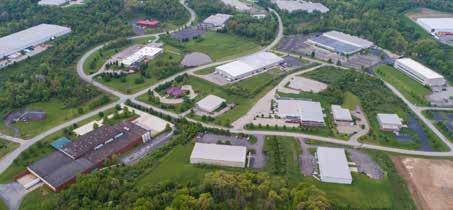


(From left) PJ Dick’s Chris Cooper, and Jeremy Meadway, David Caliguiri from CG Strategies, and Barry Bohn from The Watson Institute.
(From left) Lori Gumpher and Krista Gumpher from Gumpher Inc., Ashley Scheider from Ferry Electric, and NECA’s Joelle Salerno.
(From left) Chris McCune from Somera Road, CBRE’s Carmine DiLucente and Mamadou Balde, and Chris DiLorenzo from Turner Construction at the NAIOP Golf Outing at Fox Chapel Golf Club on June 3.






AWARDS & CONTRACTS
Volpatt Construction was selected by the Diocese of Pittsburgh to be the general contractor for the $4 million Synod Hall renovations at St. Paul’s Cathedral in Oakland. The architect is LGA Partners.
Duquesne University awarded a contract to Gilbane Building Company for the renovations to Mellon Hall Labs 310, 221A, and 255. The architect is MCF Architects.
Jendoco Construction Corp. was awarded the contract for the $1.1 million Duquesne University Kline School of Law Lobby and Lounge Renovations. Architectural Innovations is the architect.
Jendoco Construction Corp. is doing preconstruction for Bloomfield Garfield Corporation on the proposed redevelopment of the former B’Nai Israel rotunda on North Negley Avenue. The architect for the $12 million community and arts center is Rothschild Doyno Collaborative.
Myla USA LLC awarded a contract to Shannon Construction for the renovations to create a new conference center at 2000 Park Lane in North Fayette Township. NEXT Architecture is the architect.
Shannon Construction is the construction manager-agency for the buildout of the Life Male STEAM Academy in Building 7 at Penn Center East in Wilkins Township. The architect is Desmone Architects.
Kokosing Industrial was the successful general construction bidder on the $4.5 million Lime Slurry and Sodium Permanganate Systems Improvements at the Pittsburgh Water and Sewer Authority’s Aspinwall Plant. The engineer is Whitman Requardt & Associates.
Upper St. Clair Township awarded a contract for general construction to DiMarco Construction for its new $7 million Morton Field Complex. The architect for the new complex, which includes four buildings totaling 3,830 square feet and new athletic fields, is EPM Architecture.
FMS Construction was the successful contractor on the renovations to the Clifton Station for the Bethel Volunteer Fire Company in Bethel Park. EPM Architecture is the architect.
Highmark selected Turner Construction Co. as construction manager for the new $2 million outdoor terrace at Fifth Avenue Place, 120 Fifth Avenue in Downtown. The architect is AE7 Architects.
TEDCO Construction was selected as general contractor for the renovations to the 46th floor of 600 Grant Street for UBS. The architect for the $2 million renovation is Verderame | Cale Architecture pllc.
PJ Dick is continuing work at University of Pittsburgh’s Fifth and Halket and will complete the fit out for floors three through eight of the classroom/laboratory building.
PJ Dick is the CM at risk for demolition of the UPMC McKeesport Kelly Building. The building is seven stories with a two-story annex, including basement/foundation walls and slab on grade. The basement void will be backfilled to the existing grade and planted.
Hampton Township School District hired PJ Dick as the CM Agent to manage phase two of the high school renovation project. The $25 million project will be completed in multiple phases over a two-year period. Construction is slated to begin by March/April 2025.
PJ Dick’s West Chester office is continuing work at Presbyterian Senior Living’s Cathedral Village Philadelphia campus to refresh the existing corridors for Buildings G (8,145 square feet) and H (8,034 square feet), including new lighting, ceilings, epoxy flooring and paint. A new domestic water service to all 10 buildings on the campus is also included in the scope of work.
Mascaro will be renovating several rooms on the third floor of Thaw Hall for a research laboratory program at the University of Pittsburgh. The new design will include utilization of the previously purchased air handling unit as well as utilization of previously purchased electrical and mechanical equipment, lab casework, and associated components.
Pittsburgh Parking Authority awarded a $5.2 million contract to Carl Walker Construction for the repairs and preventative maintenance of the Mellon Square Parking Garage. The architect is Desman Associates.
Rycon Construction was awarded the general construction contract for the $46.2 million new Steel Valley Elementary School in Munhall, PA. The 128,000 square foot new facility was designed by DRAW Collective.
The University of Pittsburgh selected Rycon’s Building Group to handle the $5.2 million renovation of the labs on floors 11 and 12 within Chevron Science Center in Oakland, PA.
Rycon’s Special Projects Group is the construction manager for the $685,000 fit-out of a new Playa Bowls location in the Terminal Building in Pittsburgh’s Strip District neighborhood.
Two Starbucks renovations are underway by Rycon’s Special Projects Group within a residence hall at the University of Pittsburgh and within a medical office in Orlando, FL.
Baird selected Rycon’s Special Projects Group for the fit-out of their new $1.5 million, 10,000 square foot office space located in Riverfront West, part of the Strip District’s 3 Crossings Development.
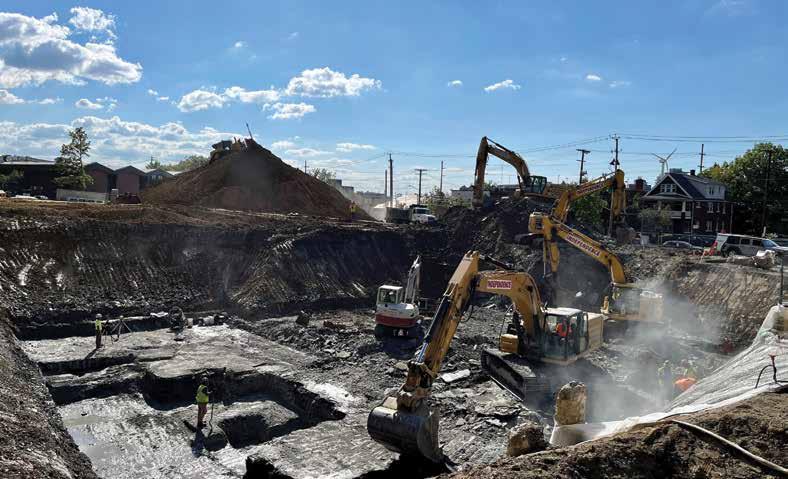
The Chick-fil-A at the Waterfront in Homestead, PA is undergoing a $1 million renovation by Rycon’s Special Projects Group.
Rycon’s Special Projects Group is handling two footwear remodels totaling over 9,400 square feet for Dick’s Sporting Goods in Hattiesburg, MS and Orange Park, FL.
Within Liberty Center in downtown Pittsburgh, Rycon’s Special Projects Group is renovating Accenture’s 7,700 square foot office space.
UPMC McKeesport Hospital has selected Landau Building Company to serve as the general contractor for the renovation of the existing 4,450 square foot patient space into a Wound Care Center. LGA Partners is the project architect.
Landau Building Company has been selected as the construction manager for the renovation of the Rangos Ballroom in the Jared L. Cohon University Center at Carnegie Mellon University. This project, in collaboration with Bohlin Cywinski Jackson, involves a 7,560 square foot phased renovation starting this summer.
Landau Building Company is the general contractor for the Radiation Oncology CT Replacement project at UPMC Magee Women’s Hospital. Designed by RM Creative, this renovation includes modifications to the existing CT room to accommodate new equipment, a new procedure room, and
updates to associated control rooms, administrative spaces, and patient care holding areas and exam rooms.
Landau Building Company has started renovations on the JROC PET-CT Replacement project at UPMC Shadyside Hospital, with RM Creative serving as the architect.
Landau Building Company is the construction manager for the renovations to the Emergency Department’s Infection Prevention & Containment Unit at WVUM Ruby Memorial Hospital. Hafer is the design professional.
AM Higley is the construction manager for the Robert Morris University School of Engineering, Math, and Science Advance Biology Lab renovation. The architect is Ross Bianco Architect/RBA International.
Duquesne University awarded contracts to A. Martini & Co. for $1.7 million fire protection upgrades at Fisher Hall designed by Barton Associates; and $1.2 million for office and elevator lobby renovations at Rockwell Hall. LGA Partners is the architect.
Wabtec selected A. Martini & Co. to build its new research space in Hunker, PA. The architect is Strada Architecture.
F.J. Busse Co. is the general contractor for the renovations to Strassberger McKenna Gutnick & Gefsky’s offices on the 22nd floor of 4 Gateway Center. The project was designed by Desmone Architects.




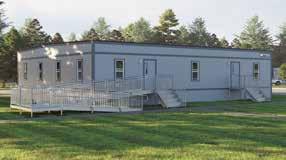

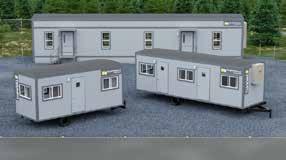
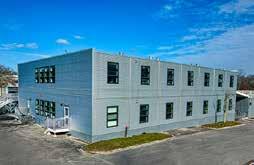

Photograph: Alta Via Market Square
Photography by Mike Christ
FACES & NEW PLACES
Rycon Construction announced the promotion of Reid Cservak to vice president, business development & marketing. Cservak will focus on Rycon’s expansion across multiple markets nationally. He is a graduate of the University of Cincinnati with a B.S. in Civil Engineering.
Rycon’s Pittsburgh Special Projects Group is excited to welcome Amaya Bookamyer as a project coordinator. She is currently pursuing a degree at Penn State University.
With over 27 years’ experience, Melissa Braun joined Rycon’s Human Resources Department as a human resources generalist.
University of Alabama alumnus, Austin Konieczka joined Rycon’s Marketing Department as a marketing coordinator.
Alex Nutter, a Kent State University alumnus, has joined Rycon’s Pittsburgh Service Department as a project manager.
Alivia Oulton, a Youngstown State University alumna, joined Rycon’s Marketing Department as a proposal coordinator.
Rycon’s Accounting Department welcomed Ashley Rieg as an accounts payable data entry clerk.
Indiana University of Pennsylvania alumnus, Matt Robinson, joined Rycon’s Pittsburgh Service Department as a project manager.
Slippery Rock University alumna, Megan Sedlemeyer, has joined Rycon’s Human Resources Department as a human resources generalist.
PJ Dick Construction Services Group – Concrete Division welcomed Project Engineer John Caldwell. John is a 2024 Architectural Engineering graduate from The Pennsylvania State University.
Krista Staley joined PJ Dick’s Family of Companies as deputy general counsel. She has a Juris Doctor degree from the University of Pittsburgh School of Law and a Bachelor of Applied Science in Urban and Regional Planning from Ball State University. Prior to joining PJTC Holdings, Krista worked at Babst Calland for 13 years as an associate and shareholder.
Clare Malone joined PJ Dick as a project engineer, where she will be assigned to the Pressley Ridge New Campus Day School project. She graduated from the University of Pittsburgh - Johnstown with a Bachelor of Science in Mechanical Engineering in 2024.
Shannon Construction announced that Kimm Naugle had joined the company as project engineer. She will serve as a project engineer for the Commonwealth Charter Academy in Moosic, Lackawanna County, PA.
Stephen Stribling joined Facility Support Services, LLC as an estimator. With more than 25 years in construction,
Stribling’s expertise includes estimating, project management and operations.
On May 20, Kayla Gorol joined Mascaro as the corporate administrator and will also be supporting the human resources department.
Megan Walzer joined Mascaro as a project administrator on May 20.
Turner Pittsburgh welcomed seven interns. Justin Bass, Jobi Cook, Anthony DeCostello, Peter Johnson, Suraya Rahim, Sage Smith, and Zach Vogel will be assisting in various departments and on job sites.
Landau Building Company welcomed Justin Yokaitis as project manager. With a 23-year career in the construction industry, Justin brings extensive experience spanning across various architectural, electrical, and general contracting roles.
CJ Saylor joins Landau Building Company as project engineer. CJ is a recent graduate of Grove City College and is assisting Landau’s team with the renovation of its historic Rockwell Hall project.
Tim Pratt recently joined AM Higley as a project manager in the Pittsburgh office. Pratt is a graduate of the University of Pittsburgh with a Bachelor of Science in Civil and Environmental Engineering.
AM Higley announced the promotion of Mike Larson-Edwards to regional director, Pennsylvania. Mike, who has been with AM Higley since 2021, has recently taken on the role and now oversees day-to-day operations, business development, and the growth in western Pennsylvania.
Jason Scheible has been promoted to project executive in AM Higley’s Pittsburgh office. Scheible has been with AM Higley since 2019.
Jaylyn Spitnale joined Massaro as the new graphic design specialist. She was hired earlier this year after graduating from Bowling Green State University with a B.S. in Technology/ Visual Communication as well as a minor in computer science.
Massaro Corporation hired Zak Sovek as an estimator earlier this spring. After graduating from Robert Morris University, he worked in various positions as an estimator and project management.
Patrick C. Schrum was hired by Massaro as a site safety specialist. Patrick graduated from Indiana University of Pennsylvania with a degree in Safety Science and Criminology. He has been in the industry since 2019 and holds an array of safety certificates.

2024 BUILDING EXCELLENCE AWARDS

M A R K Y O U R C A L E N D A R S F O R :
E N T R I E S F O R T H E A W A R D S A R E D U E : S E P T E M B E R 6 , 2 0 2 4 THE CONSTRUCTION INDUSTRY EVENING OF EXCLLENCE
THURSDAY, FEBRUARY 27, 2025


2024 MBA OFFICERS
President
Raymond A. Volpatt, Jr., P.E.
Volpatt Construction Corporation
Vice President and Treasurer
Michael R. Mascaro
Mascaro Construction Company, LP
Secretary/Executive Director
David D. Daquelente
2024 MBA BOARD OF DIRECTORS
John Paul Busse
F.J. Busse Company, Inc.
Alexander G. Dick
Dick Building Company
James T. Frantz
TEDCO Construction Corporation
Michael Kuhn
Jendoco Construction Corporation
Jeffrey C. Landau
Landau Building Company
Anthony F. Martini
A. Martini & Co.
Steven M. Massaro, Past President
Massaro Corporation
David P. Meuschke
Burchick Construction Company, Inc.
M. Dean Mosites
Mosites Construction Company
Jake Ploeger
PJ Dick Incorporated
Jodi L. Rennie
Turner Construction Company
John W. Sabatos
Rycon Construction, Inc.
Neal Rivers (MICA President)
Easley & Rivers, Inc.
GENERAL CONTRACTORS
A. Martini & Co.
AIMS Construction
Allegheny Construction Group, Inc.
Burchick Construction Company, Inc.
Caliber Contracting Services, Inc.
Carl Walker Construction, Inc.
CH&D Enterprises, Inc.
CPS Construction Group
Dick Building Company, LLC
DiMarco Construction Co., Inc.
E&G Development, Inc.
F.J. Busse Company, Inc.
Facility Support Services, LLC
FMS Construction Company
Fred L. Burns, Inc.
Gilbane Building Company
Independence Excavating, Inc.
Jendoco Construction Corporation
Kokosing Industrial Incorporated
Landau Building Company
Mascaro Construction Company, LP
Massaro Corporation
McCrossin
Menard USA
Mosites Construction Company
Nicholson Construction Company
PJ Dick Incorporated
Rocky Bleier Construction Group
Rycon Construction, Inc.
Shannon Construction Company
Stevens Engineers & Constructors, Inc.
TEDCO Construction Corporation
The Albert M. Higley Company, LLC
Turner Construction Company
Uhl Construction Company, Inc.
Volpatt Construction Corporation
MBA MEMBERSHIP
SPECIALTY CONTRACTORS
A Crane Rental, LLC
A. Folino Construction, Inc.
A.J. Vater & Company, Inc.
Abate Irwin, Inc.
ABMECH Acquisitions, LLC
ACE Lightning Protection, Inc.
Advantage Steel & Construction, LLC
All Crane Rental of Pennsylvania, LLC
Alliance Drywall Interiors, Inc.
Amelie Construction & Supply, LLC
Amthor Steel, Inc.
Brayman Construction Corporation
Bristol Environmental, Inc.
Bruce & Merrilees Electric Company
Bryan Construction, Inc.
Burke & Company, LLC dba S.P. McCarl & Company
Burnham Industrial Contractors, Inc.
Buzzelli Group LLC
Centerpoint Painting Systems
Century Steel Erectors Co., LP
Clista Electric, Inc.
Cost Company
Costa Contracting, Inc.
Cuddy Roofing Company, Inc.
Dagostino Electronic Services
D-M Products, Inc.
Dom DeMarco Construction, Inc.
Donley’s Concrete Group
Douglass Pile Company, Inc.
Easley & Rivers, Inc.
EMCOR Services Scalise Industries
Fay, S&B USA Construction
Ferry Electric Company
First American Industries, Inc.
Flooring Contractors of Pittsburgh
Franco Associates
G. Kidd Inc.
Gaven Industries, Inc.
Geo V Hamilton, Inc.
Giffin Interior & Fixture, Inc.
Gregori Construction Inc.
Gumpher, Inc.
Gunning, Inc.
Hanlon Electric Company
Harris Masonry, Inc.
Hatzel & Buehler, Inc.
HOFF Enterprises, Inc.
Howard Concrete Pumping, Inc.
Hunt Valley Environmental, LLC
J.J. Morris & Sons, Inc.
JLJI Enterprises, Inc.
Kalkreuth Roofing & Sheet Metal, Inc.
KELLER North America
Keystone Electrical Systems, Inc.
Kirby Electric, Inc.
Kusler Masonry, Inc.
L & E Concrete Pumping Inc.
Lanco Electric, Inc.
Lighthouse Electric Company, Inc.
Lisanti Painting Company
Marsa, Inc.
Massaro Industries, Inc.
Master Woodcraft Corporation
Matcon Diamond, Inc.
Maxim Crane Works, LP
McCrossin Foundations, LLC
McKamish, Inc.
Mele & Mele & Sons, Inc.
Mohawk Construction & Supply Inc
Next 150 Construction LLC
Noralco Corporation
Paramount Flooring Associates, Inc.
Phoenix Roofing, Inc.
Pittsburgh Interior Systems, Inc.
Precision Environmental Company
Pullman SST
RAM Acoustical Corporation
Redstone Flooring, LLC
Renick Brothers Construction Co.
Richard Goettle, Inc.
Right Electric, Inc.
Ruthrauff | Sauer, LLC
Saint’s Painting Company, Inc.
Sargent Electric Company
Schindler Elevator
Schlaegle Design Build Associates, Inc.
Schnabel Foundation Company
Specified Systems, Inc.
Spectrum Environmental, Inc.
SSM Industries, Inc.
Swank Construction Company, LLC
T.D. Patrinos Painting & Contracting Company
Tarax Service Systems, Inc.
TRE Construction
Triple 3 Construction, LLC
Tri-State Flooring, Inc.
W.G. Tomko, Inc.
W.O. Grubb Steel Erection, Inc.
Wayne Crouse, Inc.
Worldwide Services LLC
Wright Commercial Floors
Wyatt Incorporated
AFFILIATE MEMBERS
4CTechnologies
84 Lumber Company
A. L. Harding & Company
A.R. Chambers and Son, Inc.
ADMAR Construction Equipment and Supply
AEC Online Store
African American Chamber of Commerce of Western PA
Allegheny County Airport AuthorityPittsburgh International Airport
Alliant
American Contractors Insurance Group
American Producers Supply Company, Inc.
Amerisafe Group
AmeriServ Trust and Financial Services Company
Assured Partners of PA, LLC
Atlantic Engineering Services
Atlas Marketing
Atlas Wholesale Co., Inc.
AUROS Group
Babst Calland
Baker Tilly Virchow Krause, LLP
BDO USA, P.A.
Beemac Inc.
Beth-Hanover Supply Co., Inc.
Black Diamond Equipment Rental
Bowles Rice
Bronder & Company, P.C.
Building Point Ohio Valley
Burns & Scalo Real Estate Services, Inc.
Burns White, LLC
Cadnetics, Inc.
Case | Sabatini
Chartwell Investment Partners
Chubb Group of Insurance Companies
Civil & Environmental Consultants, Inc.
Clark Hill PLC
Cleveland Brothers Equipment Co., Inc.
CliftonLarsonAllen LLP
Cohen and Company
Cohen Seglias Pallas Greenhall & Furman PC
Computer Fellows Inc.
Cozen O’Connor
CTR Payroll & HR
Dentons Cohen & Grigsby P.C.
DesignGroup
Desmone Architects
Dickie, McCamey & Chilcote, P.C.
Dingess, Foster, Luciana, Davidson & Chleboski LLP
Dollar Bank
DRAW Collective Architecture
Eckert Seamans Cherin & Mellott
ECS Mid Atlantic, LLC
EPIC Insurance Brokers & Consultants
EquipmentShare
Fahringer, McCarty, Grey, Inc.
FDR Safety, LLC
FieldForce Equipment Sales & Rentals, LLC
First National Insurance Agency
Fisher Phillips
Graystone Consulting Pittsburgh
H2R CPA
Henderson Brothers, Inc.
Henry Rossi & Co., LLP
HHSDR Architects/Engineers
Highway Equipment Company
Hillis Carnes Engineering Associates, Inc.
Huth Technologies LLC
IMA Corp
Intertek - PSI
J.S. Held
JLL
K&L Gates LLP
Karpinski Engineering
L & W Supply
LaFace & McGovern Associates, Inc.
Langan Engineering & Environmental Services
Liberty Insurance Agency
Liberty Mutual Surety
Lytle EAP Partners/Lytle Testing Services, Inc.
Maiello, Brungo & Maiello
Marsh
Marthinsen & Salvitti Insurance Group
McKim & Creed, Inc.
McNees Wallace & Nurick LLC
Meyer, Unkovic & Scott LLP
Meyers Company
Michael Baker International
Michael Brothers Companies
Milwaukee Tool
Mobile Air, Inc.
Mobile Medical Corporation
Morgan, Lewis & Bockius LLP
MSA Safety
MSW Supply
Multivista
NCI - Nursing Corps
New Millennium Building Systems
Newlons International Sales, LLC
NextEra Energy
Ohio Valley Drywall Supply
OVD Insurance
PenTrust Real Estate Advisory Services, Inc.
PGH Networks
Philadelphia Insurance Companies
Pietragallo Gordon Alfano Bosick & Raspanti, LLP
Pittsburgh Mobile Concrete, Inc.
R.J. Bridges Corporation
Reed Building Supply
Repco II
Republic Services, Inc.
RJR Safety Inc.
Schneider Downs & Company, Inc.
Scotti Law Group
Seubert & Associates, Inc.
Solutions 21
Sprague Energy
Stanley Black & Decker
Stephany Associates, Inc.
Steptoe & Johnson, PLLC
Suburban Propane
Sunbelt Rentals, Inc.
The Gateway Engineers, Inc.
The Sherwin-Williams Co.
Tom Brown, Inc.
Travelers Bond & Financial Products
Triangle Fastener Corporation
Triumph Modular
Tucker Arensberg, P.C.
UBS Financial Services, Inc.
United Rentals
UPMC Work Partners
USI Insurance Services
Werner Co.
White Cap
Willscot-Mobile Mini
WNA Engineering, Inc.
WTW - Willis Towers Watson
Zurich NA Construction


ALCOSAN Final Settling Tanks
CLOSING OUT
GUARANTEEING A RESILIENT FUTURE FOR WESTERN PA
BY CHRIS CIESLAK
The Pittsburgh region is at a pivotal moment in its development: flex and adapt to external forces impacting our stability and economic future or repeat past mistakes, taking too long to recognize and innovate in response to market changes.
Increasingly, severe weather events, regulatory changes, and market and social forces are pointing to one smart choice: migrate to development principles that are grounded in resiliency and open to change.
Our buildings, which globally account for approximately 37 percent of global CO2 emissions and 40 percent of all U. S. primary energy use, stand at the epicenter of extreme weather impacts. This is true even in Western Pennsylvania, where our geographic location and topography provide some protection. Heavy storms are dropping 60 percent more rain than they used to, creating a cadence of power outages, triggering landslides, and bringing record flooding to our area. In Pittsburgh, stormwater surges are creating sewer overflows into our rivers while soaring temperatures force local students to move to remote learning.
These challenges, though significant, bring opportunities for innovation and leadership in the way we design, build, renovate, and power our office buildings, schools, hospitals, and homes. The choices that architects, builders, and developers are making now will for years to come determine Pittsburgh’s resiliency and in turn, its image as a desirable place to live, work, and locate a business.
Recognizing that sustainable design – design that is energy efficient, resilient to weather impacts, and mitigates carbon emissions and adverse environmental impacts - is good for business is critical to our future as a region and to overcoming barriers to change.
From a financial perspective, upfront investments in energy efficiency measures such as envelope upgrades, addressing refrigerant leaks, installing building control systems and demand management programs, upgrading heating systems to heat pumps, and replacing older lighting provide protection against rapidly rising utility costs. In addition to savings, incorporating on-site renewable energy sources such as solar panels or geothermal heat provides stability and protection against grid fluctuations and power outages.
Market advantages to green and high-performance building practices continue to accumulate as companies and entire industries commit to environmental, social, and governance (ESG) goals and allocate resources to reach them. Thomson Reuters Institute predicts:
“ESG issues will transition from being optional extras to integral elements of corporate strategy [and] sustainability will become deeply embedded in the financial foundations of companies… Additionally, Scope 3 rules, which require reporting companies to monitor all indirect emissions that occur throughout the supply chain and among third-party vendors, will drive
significant transformations across all sectors.”
And according to the U.S. Green Building Council - U.S. Commercial Real Estate Market 2023 report, one in four of the largest commercial real estate investment trusts are making science-based commitments to decarbonize their buildings.
New regulations around clean and efficient energy continue to roll out at the federal level and in some states.
The U.S. federal government, the largest purchaser in the world, with annual purchasing power of over $630 billion, is prioritizing the use of American-made, lowercarbon construction materials in federal procurement and federally funded projects. In 2024, the U.S. Department of Energy implemented the Clean Energy for New Federal Buildings and Major Renovations of Federal Buildings Rule, with provisions to actively mitigate pollution, enhance air quality, foster job creation, and capitalize on cost efficiencies derived from the utilization of energyefficient infrastructure.
Regional manufacturers that stand to gain from these requirements include Nucor, Berner Air Curtains, DMI Companies, Eos Energy, Epic Metals, the Lindy Group, Form Energy, and many others. These companies are just some examples of how modeling innovation in sustainable operations and product development can position our economy for future growth.
Incentives are flowing in tandem with regulatory changes. The Inflation Reduction Act (IRA) is turbocharging incentives to commit to sustainable design and construction with tax credits ranging up to 30 percent for renewable energy and energy efficiency investments.
The good news is that in the Pittsburgh region, momentum is building for a resilient future.
Greater Pittsburgh has been named a U.N. Centre of Excellence in High-Performing Buildings, and our Pittsburgh and Erie 2030 Districts are leading by example, with properties in Pittsburgh alone achieving a 48 percent reduction in carbon emissions, or 507,000 metric tons of CO2e emissions avoided, and a savings of $60.5 million in energy utility costs in 2023.
With Federal rule changes driving demand for healthy, energy-efficient projects and materials, this is an unprecedented time for Western Pennsylvania’s design and construction industry to lock in its leadership in resilience. Reach out to GBA to learn more, and for guidance on pursuing your company’s sustainability goals.
Chris Cieslak is the chief operating officer for Green Building Alliance in Pittsburgh. She can be reached at chrisc@ gbapgh.org

